11 radar reflectors tested : Not all models are really easy to see
Alexander Worms
· 14.05.2023
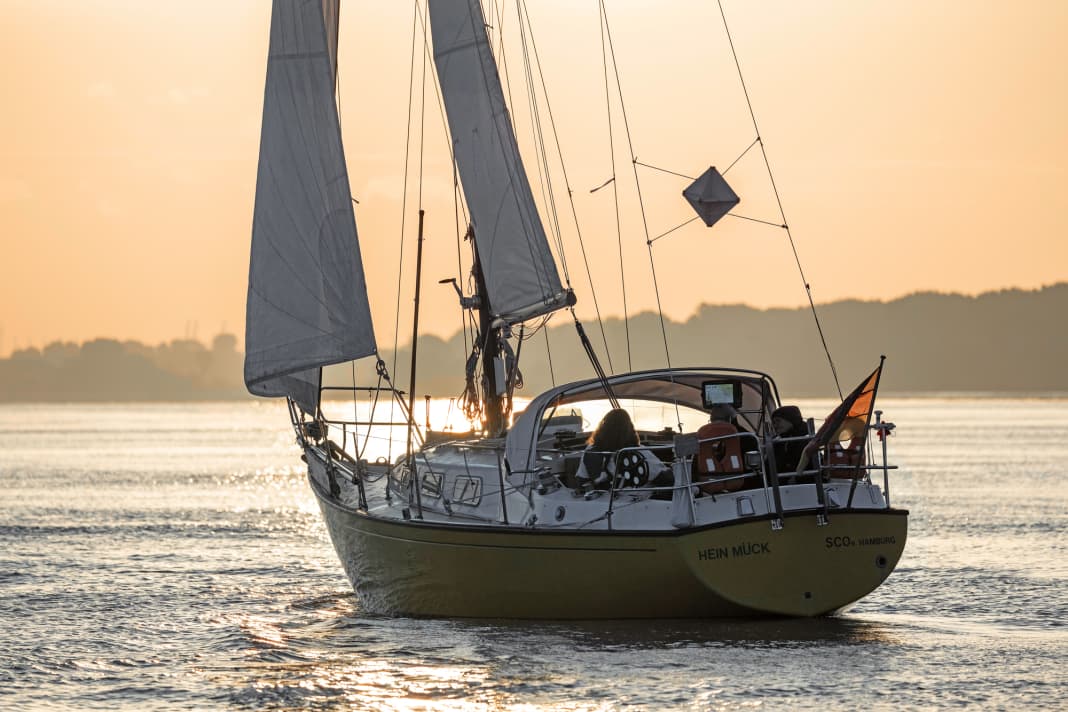

This is how we tested
11 radar reflectors in the test: the results, how radar reflectors work, radar technology: broadband or magnetron radar.
Who needs a passive radar reflector in the age of AIS? Thanks to modern electronics, you are highly visible on the screens, certainly on those of commercial shipping. Well, the question seems justified at first glance. On closer inspection, however, the answer is clear: everyone who is on the water with commercial shipping needs such a device. This is because AIS technology is dependent on a power supply - if this fails, the yacht is no longer visible. Passive radar reflectors work at all times. What's more, there are some areas, such as the Waddenzee in the Netherlands, where a radar reflector is simply mandatory.
Not much has changed in terms of products in recent years. On the market, the Tin cube which Tubes and the Echomax . There was also a device called Trilens. This reflector is now sold under the name 3Lenzz offered again.
But how good is the performance of the reflectors in practice and when it is not a question of being seen by large devices on the bridge of a commercial vessel, but by a less powerful yacht radar? First of all, it is difficult to make generalisations and the conclusions must be formulated precisely.
Most read articles
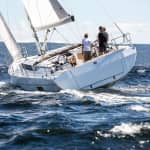
The problem is explained using an example: the 3Lenzz consists of three spheres that are mounted at an angle of 120 degrees to each other. A test by the British coastguard had already shown that it has a blind spot every 120 degrees. If radar signals hit this blind spot, the echo on the screen disappears. All reflectors have such blind spots, to a greater or lesser extent. During our test, we recognised the 3Lenzz by the fact that the echo was clearly visible, disappeared for a few orbits and then reappeared. The test boat was obviously close to a blind spot on the reflector. In practice, this would be the case when approaching with an exact bearing, for example when a ship is travelling towards an anchor berth that is not swinging. However, if the angle between the two changes by just a few degrees, there is an echo.
The conclusion that it doesn't work well because it was sometimes poorly visible in the test would not be the whole truth. The echoes were clear when measured from a different position. The conclusion is therefore that the 3Lenzz delivers good results with changing courses of approach and only shows weaknesses at three points on the full circle.
To simulate the situation on a sailing boat, we measured each reflector vertically and at an angle of 30 degrees. Here, too, some models showed weaknesses. In particular, the models with an already small reflective surface sometimes collapsed significantly. However, even the weakest reflector ensured that our test pontoon appeared on the radar screen.
The echo of each reflector was measured a total of eight times - from a distance of 0.5 and 1.5 nautical miles, vertically and at an angle of 30 degrees, using a modern broadband radar and a conventional magnetron radar. The displays of the broadband radars are shown in the individual test images. Measurements were taken from a motorboat on which both antennas were installed. The reflectors were installed at a height of around three metres on a pontoon on a wooden mast, which could also be tilted. The results were then saved using a screenshot on the Garmin devices used; these were radars commonly used on yachts. We optimised the settings of the radar unit for the medium-sized sheet metal reflector and did not change them in the further course of the test in order to ensure the same conditions for all reflectors. We only tested the two inflatable reflectors in an upright position, as these are usually suspended.
Plastimo sheet metal small
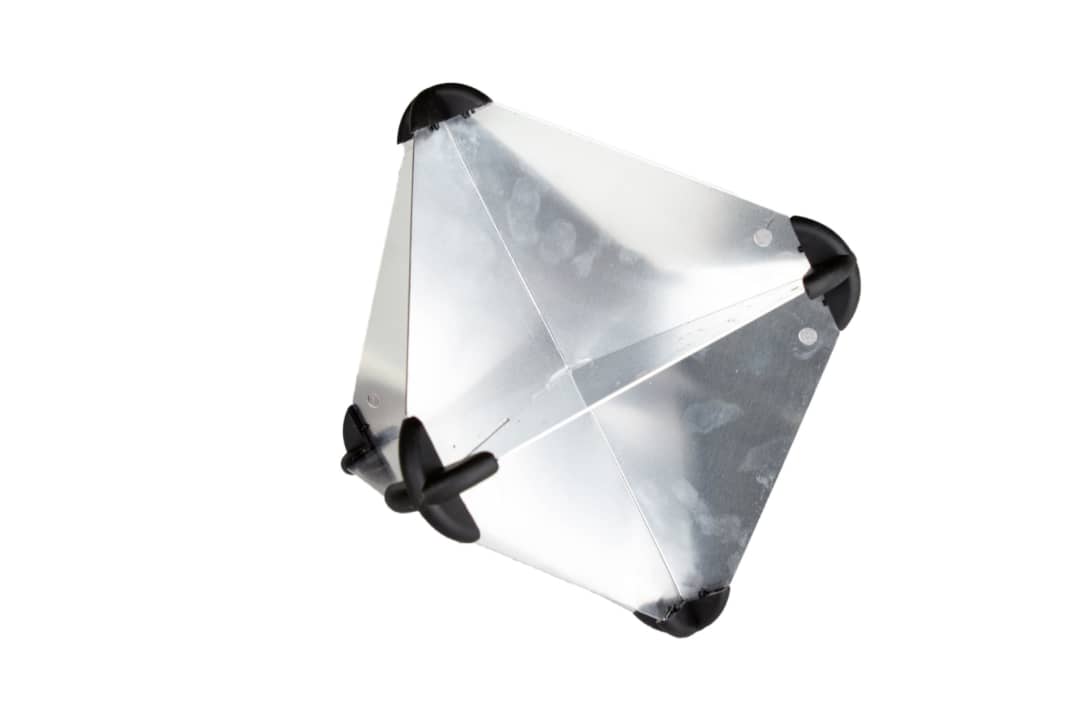
At close range, it is always easily recognisable on both devices. At greater distances, it is not visible in a vertical position; echoes only became visible when the mast was tilted. For an optimum echo, the reflector must be mounted in the rain catcher position, but this can only be the case either in an upright or tilted (in the test) position. Mounting is difficult, the metal sheets are sharp-edged.
- Weight: 0.45 kg
- Reflective surface, total: 3.0 m²
- Price: 33,92 €
- Distribution: Bukh Bremen
- Dimensions: 215 x 215 x 280 mm
- Rating: ***
Plastimo sheet metal RORC

The big brother is consistently easier to recognise on both devices at close range. From a greater distance, the solid-state radar struggles with reproduction. On the radar, the reflector cannot be seen in an upright position; when the boat is heeled over, it blends in with the tug echo. The reflector is very large. There is no opening on the inside to feed a stage through; the installation of the reflector on a sailing boat is unclear.
- Weight: 1.0 kg
- Reflective surface, total: 7.0 m²
- Price: 52,48 €
- Dimensions: 340 x 340 x 470 mm
Echomax EM 12
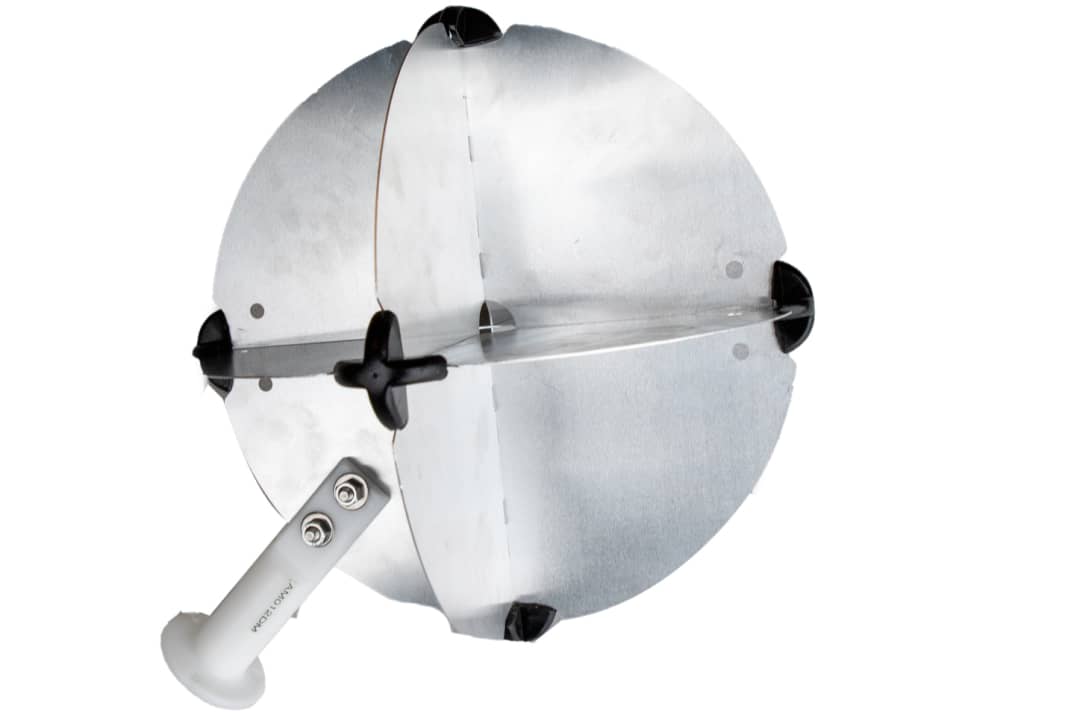
Good visibility at both distances. A rather weak echo when measured upright on the magnetron radar. At the greater distance, the reflector also clearly stands out from the echo of the tug. Mounting is easy, a foot helps with mounting on the spreader, for example. A spherical cut-out in the centre makes mounting on the stay easier as it can be threaded through. The plates are not sharp-edged.
- Weight: 0.73 kg
- Reflective surface, total: 5.5 m²
- Price: 80,50 €
- Distribution: Lindemann KG
- Dimensions: 360 mm
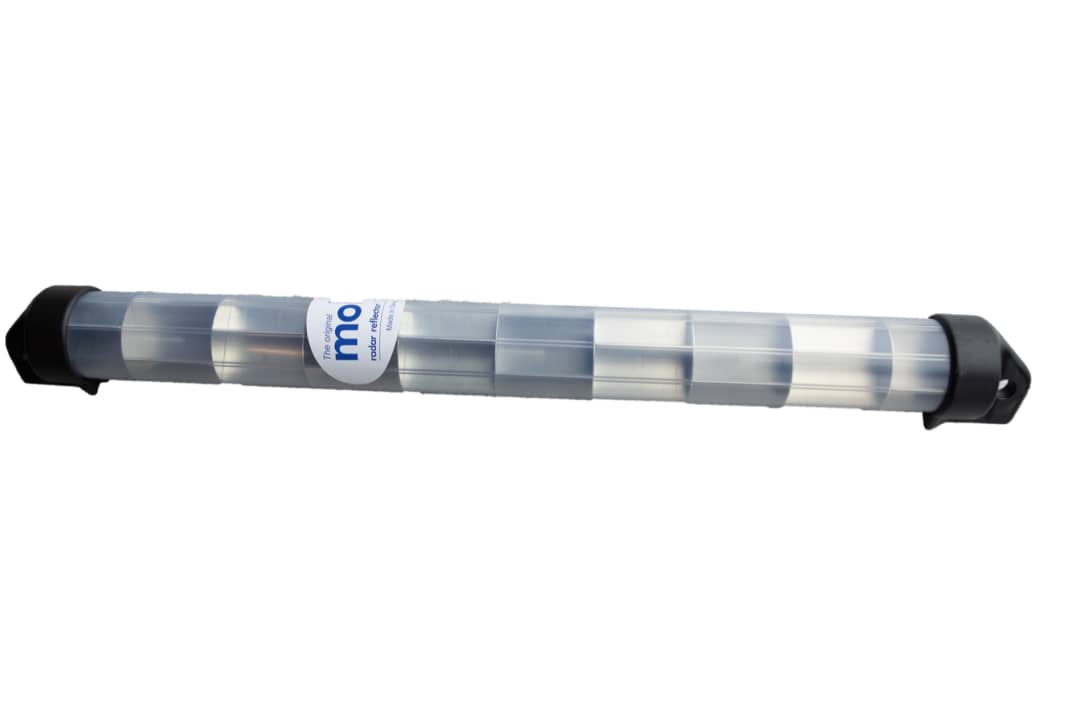
The rod is only visible as an echo from a short distance, but it is always equally good, regardless of whether it is vertical or inclined. At greater distances, it is invisible on the semiconductor radar. Only the magnetron radar can detect an echo in a vertical position. The reflector is lightweight and easy to install. However, it is more expensive than the similarly performing Plastimo tube. A base for mounting on deck is available.
- Weight: 0.38 kg
- Reflective surface, total: 2.0 m²
- Price: 49 € (as of 8/2022)
- Distribution: Lankhorst Hohorst
- Dimensions: 50 x 570 mm
Plastimo pipe small
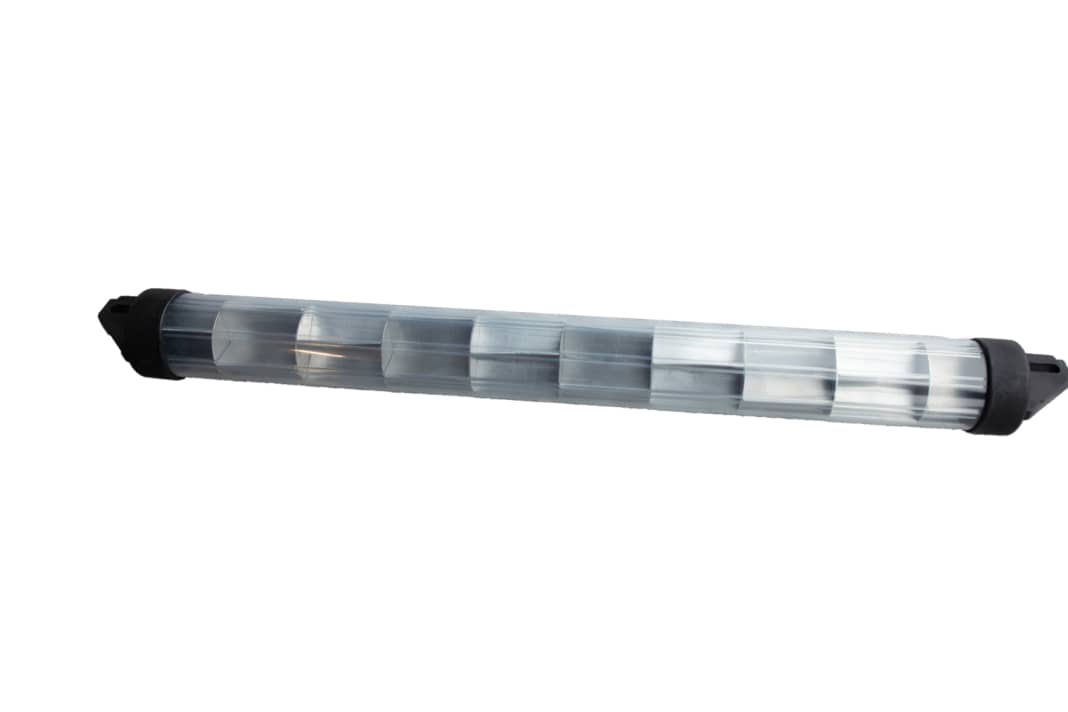
At close range, the Plastimo tube is reasonably visible, but the echoes are visibly weaker compared to the Mobri tube. At greater distances, an echo is only recognisable in a vertical position and on the semiconductor radar. The tube therefore reacts sensitively to heeling. Some of the aluminium plates inside are severely bent and not aligned at right angles. Lightest reflector in the test field.
- Weight: 0.25 kg
- Reflective surface, total. 2,0 m²
- Price. 36,53 €
- Dimensions: 50 x 580 mm
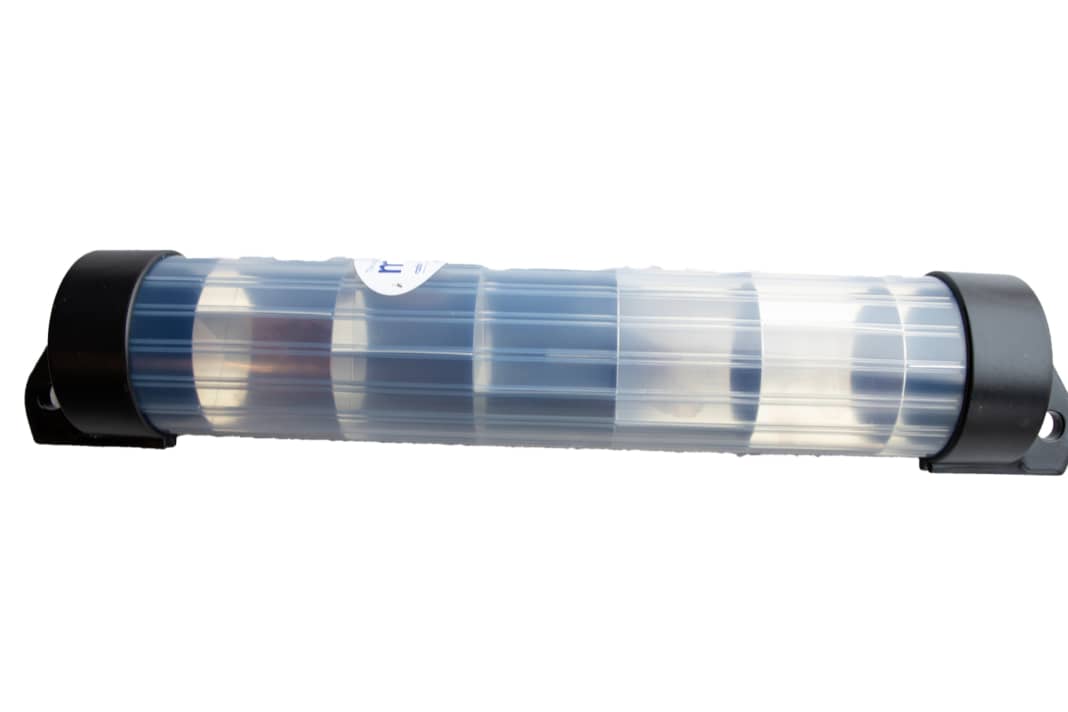
Same picture as its little brother: no visibility at a distance of 1.5 nautical miles. Only the magnetron radar in vertical position shows a slight echo. However, the Mobri is clearly visible at close range. The twice as large reflective surface compared to the smaller version does not result in a better echo. The extra weight and price are therefore not worth it. Also available with base.
- Weight: 0.88 kg
- Reflective surface, total: 4.0 m²
- Price: € 95 (as of 8/2022)
- Dimensions: 100 x 590 mm
Plastimo pipe large
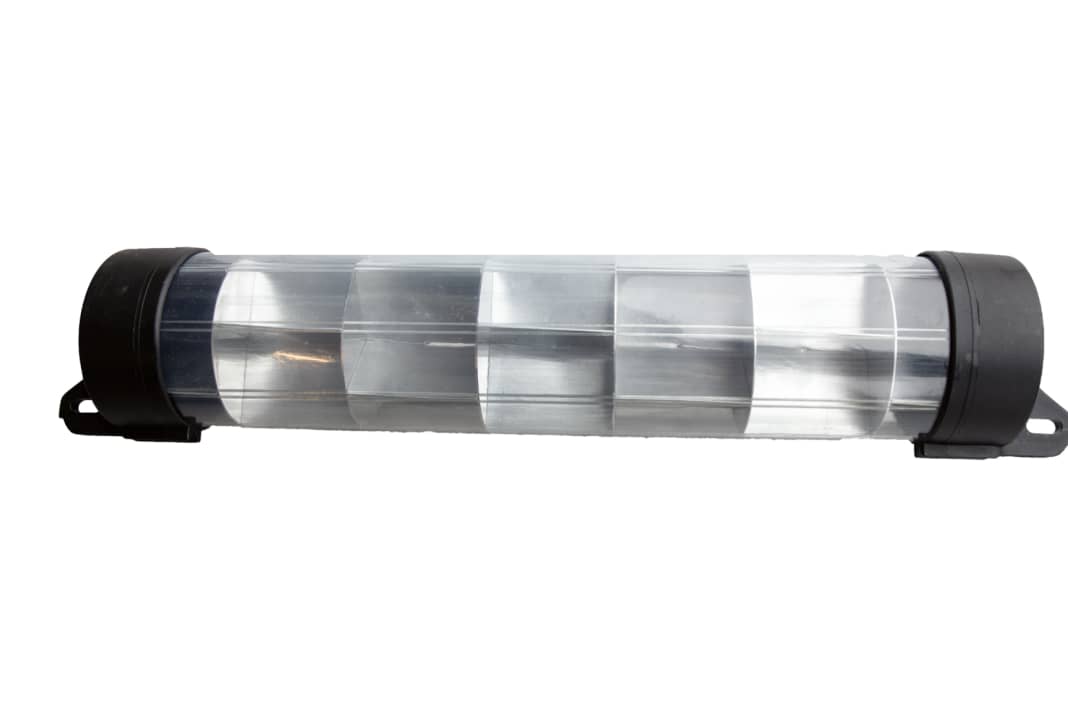
The same picture as with the competitors in tube form: At short distances, the image is usually good, although very small echoes occur with magnetron radar; at greater distances, they are almost completely invisible. Here too, the larger reflective surface does not result in a better echo. The aluminium plates inside are also bent and not mounted at right angles. The workmanship does not look very high quality due to the burrs on the plastic.
- Weight: 0.90 kg
- Price: 62,83 €
Echomax 230 BR
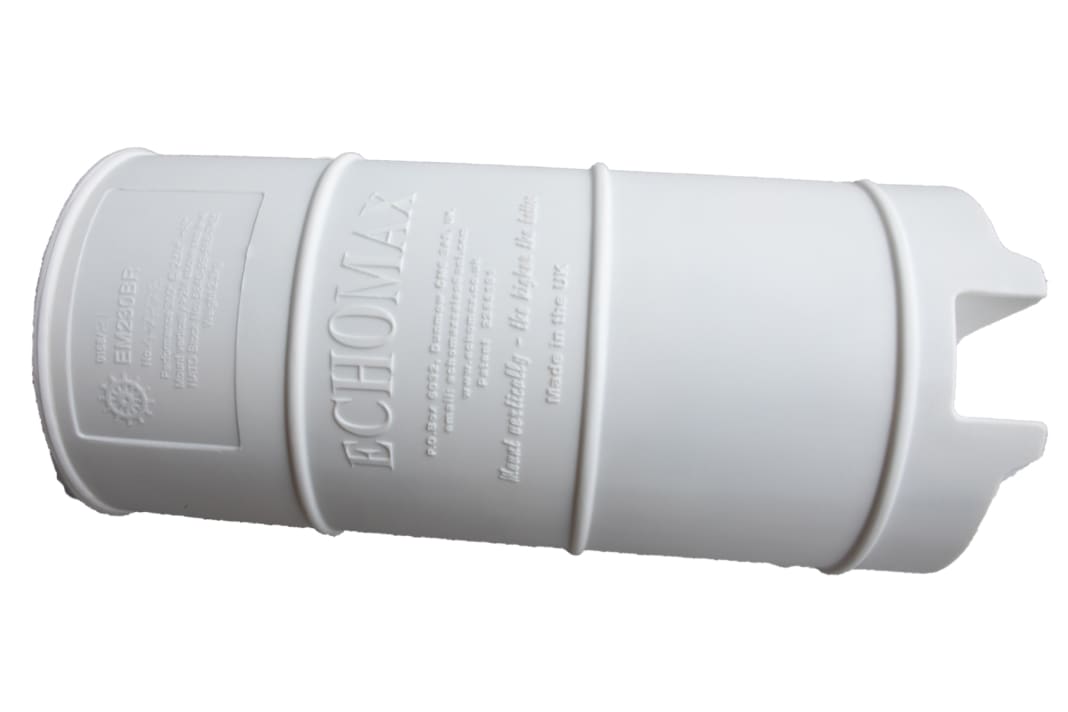
The very large device is the only reflector that produces an echo under all conditions and regardless of the radar technology. However, these are sometimes rather weak, especially if the reflector is tilted. If the reflector is upright, very good echoes are consistently displayed. The Echomax is very large and heavy, the required mounting bracket costs extra, but is very solid. Rather for large ships.
- Weight: 2.5 kg
- Reflective surface, total: 24 m²
- Price: 301,07 €
- Dimensions: 245 x 610 mm
- Evaluation: ****
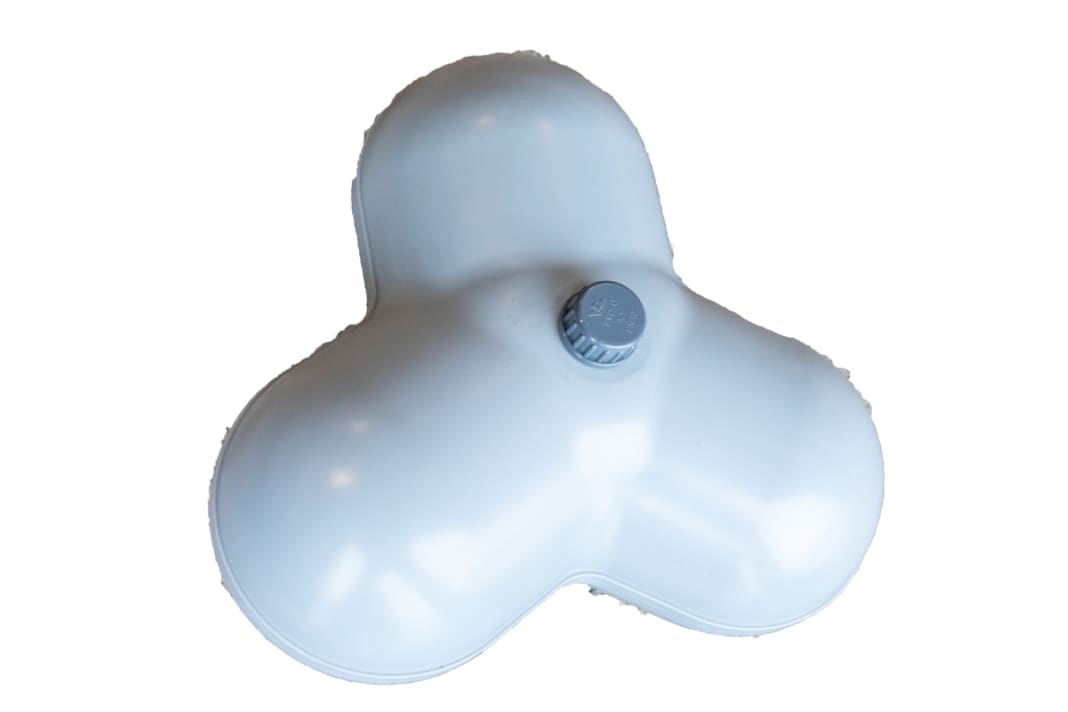
The 3Lenzz shows consistently good echoes at short distances. At greater distances, reliable echoes are only visible when the device is mounted vertically. If the device is tilted, a strong echo is only visible about every third round, but it is reliably visible in the same place. This is probably a consequence of the three-part design, see running text. The 3Lenzz is the most expensive and heaviest reflector in the test.
- Price: 389 €
- Distribution: Northwest radio
- Dimensions: 300 x 300 x 150 mm
Echomax EM230i
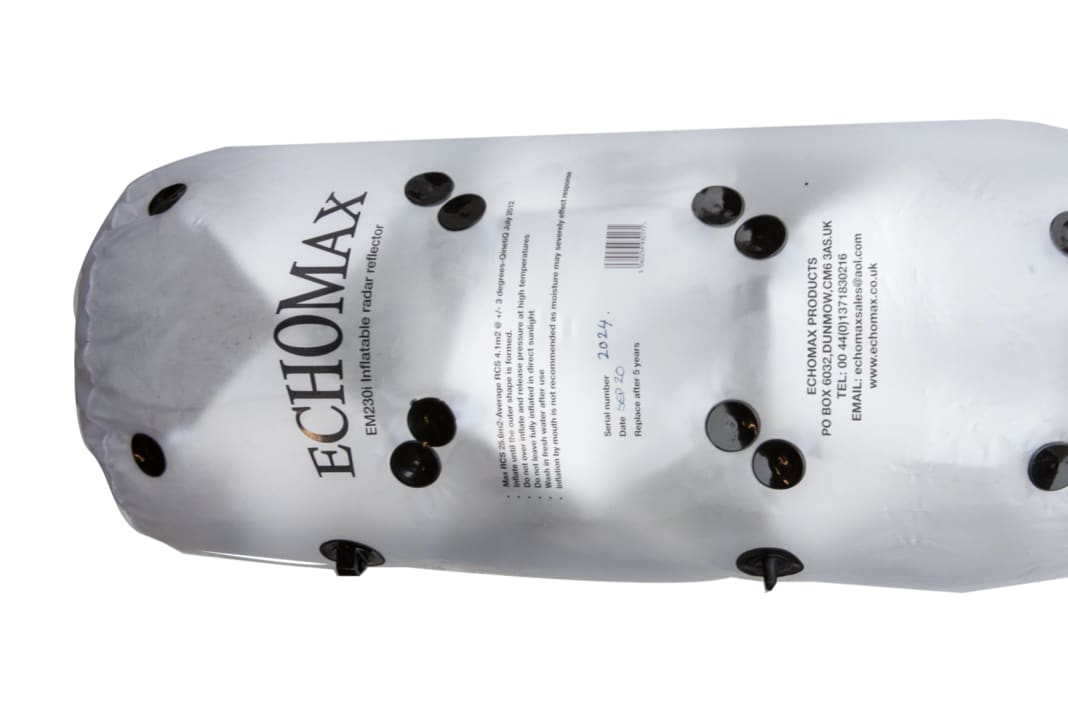
Very good and clear echoes throughout thanks to the large projection surface. Due to the suspended mounting, the reflector is always aligned vertically, so no curved values were measured. Due to its low weight, it is the ideal addition for small cruisers who only want to use the reflector when necessary. As with the ball, we recommend replacing the reflector after five years. However, it is very expensive in comparison.
- Weight: 0.42 kg
- Reflective surface, total: 17 m²
- Price: 296 €
- Dimensions: 300 x 750 mm
Plastimo inflatable
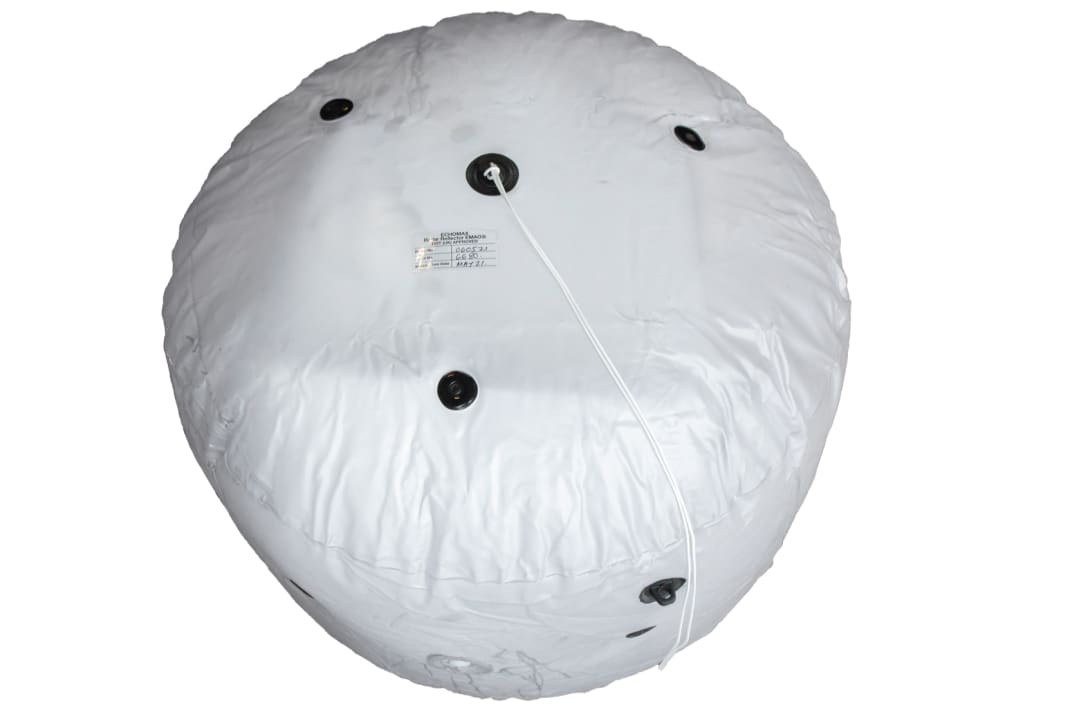
Good visibility at short distances, barely visible at greater distances. As the ball always hangs vertically when it is hoisted on a flag halyard, for example, there were no measurements when tilted. Rather poor echoes despite the comparatively large reflective surface. Unfortunately, the ball was leaking, so that constant re-inflation was necessary. The reflector is very large and light when inflated. Expensive.
- Weight: 0.6 kg
- Reflective surface: 10 m²
- Price: 268,94 €
- Dimensions: 615 mm
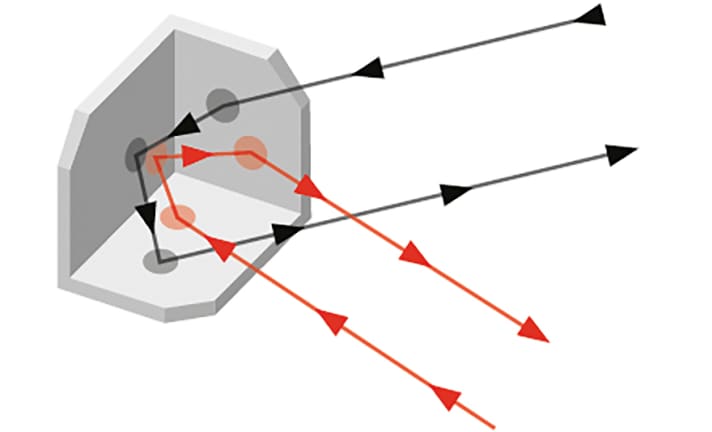
It used to be like this: after the radar unit was switched on, it took quite a while for the first image to be taken. This was because the electron beam tube, the magnetron, had to heat up first. This took time and required a lot of energy. Operating the devices also swallowed up a lot of electricity. So, on long patrols in areas with little traffic, it was only allowed to carry out a sweep every few minutes. If nothing was seen, the device switched back to stand-by mode and only used the energy required to keep the tube at the right temperature.
Modern radar devices solve this differently. There, it is not tubes that generate the signal, but semiconductors. They can also generate signals of different wavelengths. As a result, the radar is available as soon as it is switched on and requires much less power. In addition, the radiation is significantly lower, which is good for the health of the people on board. A broadband or semiconductor radar generates roughly the same radiation as a smartphone. Due to the different wavelengths, the radar can generate even more information from the reflected signals. So-called Doppler radars quickly recognise whether an echo is approaching or moving away and in which direction it is doing so without the need for complex plotting. This makes it possible to calculate the point of closest approach and the time until then.
Most read in category Equipment

- Free Newsletter

Ericson 41 Used Boat Review

Mason 33 Used Boat Review

Beneteau 311, Catalina 310 and Hunter 326 Used Boat Comparison

Maine Cat 41 Used Boat Review

Tips From A First “Sail” on the ICW

Tillerpilot Tips and Safety Cautions

Best Crimpers and Strippers for Fixing Marine Electrical Connectors

Thinking Through a Solar Power Installation

Getting the Most Out of Older Sails

How (Not) to Tie Your Boat to a Dock

Stopping Mainsheet Twist

Working with High-Tech Ropes

Fuel Lift Pump: Easy DIY Diesel Fuel System Diagnostic and Repair

Ensuring Safe Shorepower

Sinking? Check Your Stuffing Box

The Rain Catcher’s Guide

Boat Repairs for the Technically Illiterate

Boat Maintenance for the Technically Illiterate: Part 1

Whats the Best Way to Restore Clear Plastic Windows?

Mastering Precision Drilling: How to Use Drill Guides

Giving Bugs the Big Goodbye

Galley Gadgets for the Cruising Sailor

Those Extras you Don’t Need But Love to Have

UV Clothing: Is It Worth the Hype?

Preparing Yourself for Solo Sailing

How to Select Crew for a Passage or Delivery

Preparing A Boat to Sail Solo

On Watch: This 60-Year-Old Hinckley Pilot 35 is Also a Working…

On Watch: America’s Cup

On Watch: All Eyes on Europe Sail Racing

Dear Readers

Chafe Protection for Dock Lines
- Marine Electronics

Tri-Lens Radar Reflector
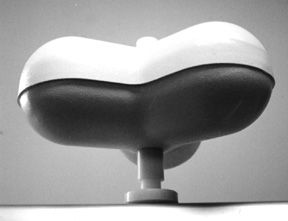
In the September 1995 issue, we reported results of radar reflector testing done at the Stanford Research Institute in Palo Alto, California. This was made possible thanks to Dick Honey, then a semi-retired senior principal scientist at SRI, uncle to former SRI research engineer, well-known navigator and sailor Stan Honey (also the guy who puts the yellow first-down band across the screen of your TV during pro football games). Stan also assisted, as did West Marines Chuck Hawley and a third member of this Bay Area brain trust, Jim Corenman.
Two Types Marine radar is of two types: X-band and S-band. The former is the type commonly carried aboard small boats. It operates at a frequency of about 9.4 GHz (9400 MHz) and has a wavelength of 3.2 centimeters (cm). S-band radar is used aboard large ships and operates at 3 GHz with a wavelength of 10 cm.
Ship operators generally use their X-band radar near shore because it has better resolution and can pick up smaller targets better than S-band, which is commonly preferred offshore due to its longer range and superior resistance to sea clutter.
Terms Radar reflectors are described in terms of their Radar Cross Selection (RCS) and their performance is measured in decibels (dB) relative to some reference, usually a 1m2 sphere (profile).
Tri-Lens Radar Reflector In our 1995 test, a recommended minimum average RCS of 2.5 m2 was adopted at the suggestion of GEC Marconi, maker of the Firdell Blipper reflector.
Radar reflector performance is a direct function of size, proportional to the fourth power of its linear size. Doubling a reflector’s size increases its effective area 16 times. In the 1995 report, we wrote: “As the smallest dimension of a reflector gets down to a few wavelengths of the radar signal, it quits acting as a reflector and starts to act as a lump of metal. Remember that a wavelength is 3.2 cm (1-1/4″) for X-band, and 10 cm (4″) for S-band. So, small reflectors must be looked at with a great deal of suspicion, as there really is no substitute for size.”
Besides strength of return, consistency also is critical. Many radar units are not continually monitored but set to automatically sound an alarm if a target registers three consecutive “hits.” One big hit wont alert the ship’s crew that a smaller vessel is in the vicinity.
Reflectors tested in the 1995 report included the octahedral Davis Echomaster and Emergency; the trihedral and dihedral-based Holland Yacht Equipment, Firdell Blipper, Mobri, High Gain Rotation and Cyclops; and the Luneburg lens-type Lensref. We also tested the Radar Flag, which was practically invisible.
1995 Results The top-performing reflector six years ago was the Davis Echomaster in the vertex up position with 0 heel, which registered 63% of returns above 2.5 m2. In the double-catch rain position and 20 heel, just 43% of returns were above 2.5 m2.
The Lensref has virtually no nulls; its polar plot is a virtual circle. Had the minimum average RCS been just 2.0 m2, the Lensref would have easily won with 100% of returns greater than the threshold. At 2.5 m2, however, just 30% of the returns exceeded the threshold. And this was at less than 18 heel, over which its performance fell off dramatically. A gimbaled mount was recommended.
The Tri-Lens Last year, we were contacted by Tim Rozendal of Rozendal Associates in Santee, California, asking us to test his new reflector. Tim said he has supplied more than 20,000 Luneburg lenses to the US Navy, Army, Air Force and Coast Guard. When he became interested in developing a product suitable for the recreational boating industry, he studied our 1995 SRI report and came up with two sizes of the Tri-Lens Radar Reflector. Due to computer problems at SRI, we were unable to have Rozendals Tri-Lens tested in the same anechoic chamber as the others. Instead, we directed Rozendal to Ohio State Universitys Electro Science Laboratory Compact Range. A copy of the 1995 report was supplied to OSU so that the same test protocol could be followed, and a Davis Echomaster was also tested as a control.
The Tri-Lens has a novel configuration of three modified Luneburg lens reflectors oriented about a vertical axis. It was measured only at X-band.
We asked Dick Honey to review the OSU report and interpret the data. In his summation to PS, he said the Tri-Lens shows “the uniform azimuthal response expected of Luneburg lenses, as well as the excellent tilt (heel) response expected from the design, i.e., each lens looks only into its 120 azimuthal sector so that the spherical reflector on the back of each lens can be quite large, with no aperture blocking as occurs with most single Luneburgs designed for 360 coverage. In other words there are very few narrow angular gaps in the coverage between each lens.”
At 0 heel, 90% of returns exceeded the 2.5 m2 threshold; at 20 heel 70% exceeded the threshold and at 25 heel 69%. The Tri-Lens easily outperformed all other reflectors in the 1995 test.
Honey nevertheless had criticism of the Tri-Lens.
“Our reservations,” he wrote, “are not with the angular coverage, but with the magnitude of the reflection. (This same reservation applies to virtually all passive radar reflectors on the market today!) The Rozendal reflectors use 5.25-inch diameter spheres inside a somewhat larger radome, the spheres being approximately 4.2 wavelengths across at X-band, but only 1.4 wavelengths across at S-band. This means that they may not be much better at scattering S-band radar signals back towards the radar than the average winch, and S-band may be the only radar in use on the high seas (if any).
“As mentioned in our earlier test, the radar cross-section (RCS) of similar reflectors increases as the fourth power of the size, so it would take a relatively small increase in the size of the Luneburg lens to bring the X-band RCS up to 10 square meters (m2) the minimum echoing area requirement in the latest International Standard (ISO 8729, Marine radar reflectors, sec. 5.1.1). That is, a perfect Luneburg lens 5.25 inches in diameter should have an RCS of about 2 m2 at X-band, but a lens only 40% larger or 7 inches in diameter should have an RCS of 10 m2. In addition, it would have a 2-wavelength diameter at S-band, where it might begin to reflect better than a winch. Unfortunately, this would add significantly to the weight of a Lens-based reflector, and weight is already a concern with these reflectors, relative to an octahedral reflector like a Davis Echomaster.
“Rozendal also offers a Mini-Lens reflector, which as expected given its small size, cannot compete with any reflector on the market except for the Mobri.
“Wouldnt it be great if a radar reflector could achieve an RCS of at least 10 m2 at X-band over 360 of azimuth with trivial nulls and wide tolerance for heel? Of course, it should be less than a foot in diameter, weigh little, and be ‘almost free,’ as they say in Mexico.”
In response to these criticisms, Rozendal agrees that the Mini Tri-Lens “does not perform well using the 2.5 m2 threshold.” The Mini Tri-Lens, he says, was “intended for small boats and coastal sailing. It should be mounted as high as possible, preferably on top of the mast. The mini Tri-Lens does not have a large RCS but gives a consistent return. It has three narrow dead spots. The Mobri has 16 dead spots and any octahedral will have eight dead spots. A premium must not only be put on RCS but on the consistency of the return as well. Anything that will help improve a vessel’s radar visibility is worthwhile, particularly shorthanded vessels and those without radar.”
The International Standard for Marine Radar Reflectors (ISO 8729) was revised in 1997 and came two years after our 1995 test. In addition to the section 5.1.1 noted above, there are other relevant sections. 5.1.2 requires that a reflector’s azimuthal polar diagram “shall be such that its response over a total of 240 is not less than 2.5 m2. The response shall not remain below this level over any single angle of more than 10.”
And section 5.2 states, “The performance of the reflector up to at least +/- 15 from the horizontal (the degree of heel) shall be such that its response at any inclination remains above .625 m2 over a total angle of 240.”
Rozendal asserts that “This specification was written around the performance spec of the largest Cyclops unit (it weighs approx. 22 lbs.). They claim their unit is the only passive reflector that meets ISO 8729. No aluminum octahedral reflector is technically able to meet this specification. The Tri-Lens exceeds this specification.”
The standard Tri-Lens measures about 12″ across, is 6″ high, and weighs about 5.5 lbs. It sells for $219 and the Mini version for $129. West Marine now carries them. Price includes a Mast Mount Bracket and a coupler that can be adapted to any marine antenna mount.
As for Honey’s wish for a 10 m2 RCS/360 reflector, Rozendal said he does make a large Tri-Lens using 8″ diameter lenses. It has a RCS of 10 m2 for 300 and minimal degradation when in elevation. It weighs around 15 lbs. and sells for $699.
While bigger is better when it comes to radar reflectors, there are practical limits aboard small boats. Installing a radar unit may be a skipper’s best defense against collision at sea-the idea being that the best safeguard is for you to see the other guy rather than hoping he sees you-but not everyone wants or can afford a radar set. And even then, hanging a relatively inexpensive passive reflector certainly doesn’t hurt.
Compared to the high cost of the Lensref (about $425), the Tri-Lens is a bargain. It costs more than the Davis Echomaster ($60), but outperforms it. If you’re in the market for a passive radar reflector, we recommend the Tri-Lens ( www.tri-lens.com ).
Contact- Rozendal Associates, Inc., 9530 Pathway St., Santee, CA 92071; 619/562-5596
Also With This Article Click here to view “Ranking of Reflectors.”
RELATED ARTICLES MORE FROM AUTHOR
Leave a reply cancel reply.
Log in to leave a comment
Latest Videos

What’s the Best Sailboats for Beginners?

Why Does A Sailboat Keel Fall Off?

The Perfect Family Sailboat! Hunter 27-2 – Boat Review

Pettit EZ-Poxy – How to Paint a Boat
Latest sailboat review.
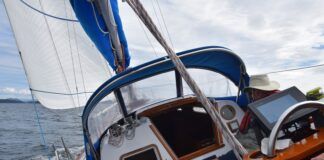
- Privacy Policy
- Do Not Sell My Personal Information
- Online Account Activation
- Privacy Manager
- View Full Site
- Advertising
- Cookie Policy
- Privacy Statement
- Terms of Service
- Cars, Trucks & Boats
- Boating & Sailing
- Boat Repairs
Install a Marine Radar Reflector
- Written by Andrew T. on Feb 02, 2010 To ensure our content is always up-to-date with current information, best practices, and professional advice, articles are routinely reviewed by industry experts with years of hands-on experience. Reviewed by H.R. Helm on Jan 22, 2020
- 2-6 hours •
- Beginner •
A marine radar reflector is used as a way of making small boats stand out on radar systems. Radar works by sending out radio waves and then drawing a picture based on the reflected radio waves. The larger the object, the bigger the reflection. A very small boat will only be shown by a small radar reflection.
A marine radar reflector will make boats more visible to other boats using the RADAR system.
Step 1 - Reasons for Radar Reflectors
Boats made out of wood or fiberglass are not normally as visible on radar systems as often as metal boats. A radar reflector can be used as a way of making your boat more visible. If you have a non metallic boat then people may find it very difficult to identify your boat on radar systems, this can put you in unnecessary danger which is why radar reflectors are so important.
Any non metallic fishing boat will need a radar reflector as a legal requirement. This needs to be visible for at least 6 miles legally.
Step 2 - Positioning the Radar Reflector
A radar reflector is quite simply a large metallic object which is fixed to your boat. Therefore, it's important that the device is fixed well above the waterline of your boat for optimum effectiveness. The metallic object can be fixed in a number of different ways. The radar reflector will need to be mounted on a pole on your boat. Choose the biggest radar reflector that your boat can accommodate.
The radar reflector needs to be located as high up on the boat as possible, by doing this you will maximize the chances of it effectively helping other sailors to identify your boat. Make sure that you locate this somewhere high up, but somewhere that won't impair the performance of your boat. This is something that you will have to think about carefully to get the best all round result.
Step 4 - Mounting the Radar Reflector
The radar reflector needs to be physically fixed to the boat, this can be done using a large pole or support. A large pole needs to be bolted onto the top of your boat and then the radar reflector is fixed to the top. The radar reflector is simply bolted onto the pole so that it can't move.
Weather conditions out at sea can be vicious at times, the radar reflector needs to be securely fixed so that it can't come loose even in the harshest of weather conditions.
Step 5 - Testing
Now all you need to do is test that the radar reflector really does make your boat more visible. Get another boat to try and find you to check if this works. The more visible you are, the less dangerous sailing is. The sea is full of huge commercial vessels, which is why it's so important to make yourself stand out. This will prevent any accidental collisions which could not only be costly, but also dangerous.
Related Posts
Popular articles.

- our experts
- terms of use
- privacy policy
- cookie policy
DoItYourself.com®, founded in 1995, is the leading independent home improvement and repair website. We welcome your comments and suggestions. All information is provided "AS IS." Website operating problems contact [email protected] . Questions of a Do It Yourself nature should be submitted to our " DoItYourself.com Community Forums ". Copyright© 1995-2024 MH Sub I, LLC dba Internet Brands. All rights reserved. You may freely link to this site, and use it for non-commercial use subject to our terms of use . View our Privacy Policy here .
Installing a new radar reflector
Keep your family safe while sailing with this guide on installing a radar reflector for your boat.
Installing a New Radar Reflector
As you embark on your sailing adventure with your family, safety should always be a top priority. One essential piece of safety equipment that you should consider upgrading or installing on your boat is a radar reflector. In this comprehensive guide, we will discuss the importance of radar reflectors, the different types available, and how to properly install one on your boat.
Table of Contents
Why you need a radar reflector, passive reflectors, active reflectors, choosing the right radar reflector for your boat, mounting options, installation tips, testing your radar reflector.
A radar reflector is a device that helps make your boat more visible to other vessels’ radar systems. This is particularly important in situations where visibility is poor, such as during fog, heavy rain, or at night. By increasing your boat’s radar signature, you can significantly reduce the risk of collisions with other vessels.
In many countries, radar reflectors are required by law for certain types of boats, especially those under a specific size or those that are not made of metal. Even if it’s not a legal requirement for your boat, it’s still a wise investment to ensure the safety of your family and your vessel.
Types of Radar Reflectors
There are two main types of radar reflectors: passive and active. Each type has its own advantages and disadvantages, so it’s essential to understand the differences before making a decision.
Passive radar reflectors are the most common type and work by reflecting the radar signals emitted by other vessels back to their radar systems. They do not require any power source and are generally low maintenance. There are several different designs of passive reflectors, including:
Octahedral reflectors: These are made of metal plates arranged in an octahedral shape, which provides a strong radar reflection from all angles. They are often collapsible for easy storage when not in use.
Luneburg lens reflectors: These are spherical devices made of materials with varying refractive indices, which focus the incoming radar signals and reflect them back to their source. They are less common than octahedral reflectors but can provide a stronger reflection.
Cylindrical reflectors: These are made of metal tubes arranged in a cylindrical shape, which can provide a strong radar reflection when oriented correctly. However, their performance can be significantly reduced if they are not aligned with the incoming radar signals.
Active radar reflectors, also known as radar target enhancers (RTEs), work by receiving the incoming radar signals and then transmitting a stronger signal back to the source. This can result in a much larger radar signature than passive reflectors, making your boat more visible to other vessels.
Active reflectors require a power source, usually your boat’s 12-volt electrical system, and may also require periodic maintenance. They are generally more expensive than passive reflectors but can provide a higher level of safety due to their increased visibility.
When selecting a radar reflector for your boat, there are several factors to consider:
Size and weight: The size and weight of the reflector should be appropriate for your boat. Larger reflectors generally provide a stronger radar reflection, but they can also be more challenging to install and may create additional wind resistance.
Performance: The performance of a radar reflector is measured in square meters of radar cross-section (RCS). A higher RCS value indicates a stronger radar reflection. Look for a reflector with an RCS value that is appropriate for your boat’s size and the conditions in which you will be sailing.
Mounting options: Consider how and where you will mount the reflector on your boat. Some reflectors come with mounting brackets or can be easily attached to existing structures, while others may require additional hardware or modifications to your boat.
Budget: Radar reflectors are available at various price points, so consider your budget when making a decision. Keep in mind that investing in a high-quality reflector can provide increased safety and peace of mind during your sailing adventures.
Installing Your Radar Reflector
Once you have chosen the right radar reflector for your boat, it’s time to install it. Proper installation is crucial to ensure the reflector’s effectiveness and your safety on the water.
There are several mounting options for radar reflectors, including:
Mast mount: Mounting the reflector on your boat’s mast is a popular option, as it provides a high and central location for optimal radar reflection. This can be done using brackets or clamps designed for your specific reflector.
Shroud mount: Another option is to mount the reflector on your boat’s shrouds (the cables that support the mast). This can be done using special shroud clamps or by attaching the reflector directly to the shrouds with cable ties or other fasteners.
Radar arch mount: If your boat has a radar arch, you can mount the reflector on the arch using brackets or clamps. This provides a high and unobstructed location for the reflector.
Pole mount: If none of the above options are suitable for your boat, you can mount the reflector on a dedicated pole. This can be a fixed or removable pole, depending on your preferences and your boat’s layout.
When installing your radar reflector, keep the following tips in mind:
Height: The higher the reflector is mounted, the more effective it will be. Aim to mount the reflector as high as possible while still being accessible for maintenance and inspection.
Clearance: Ensure there is adequate clearance around the reflector so that it is not obstructed by other structures or equipment on your boat. This is particularly important for passive reflectors, which rely on a clear line of sight to incoming radar signals.
Orientation: Make sure the reflector is oriented correctly according to the manufacturer’s instructions. This is especially important for cylindrical reflectors, which need to be aligned with the incoming radar signals for optimal performance.
Secure mounting: Ensure the reflector is securely mounted to your boat using appropriate hardware and fasteners. Regularly inspect the mounting points for signs of wear or corrosion and replace any damaged components as needed.
After installing your radar reflector, it’s essential to test its performance to ensure it is providing adequate radar reflection. This can be done by asking a nearby vessel with radar to check your boat’s radar signature or by using a radar reflector tester, which is a specialized device that measures the strength of your reflector’s radar reflection.
Regularly testing your radar reflector is a good practice to ensure it is functioning correctly and providing the necessary safety benefits.
Installing a radar reflector on your boat is an essential safety measure that can significantly reduce the risk of collisions with other vessels. By understanding the different types of reflectors available, choosing the right one for your boat, and properly installing and maintaining it, you can ensure the safety of your family and your vessel during your sailing adventures.

The Marine Electronics Hub

- Safety & SAR
The Passive Radar Reflector Solution for Sailboats
by Dan Corcoran · July 21, 2011
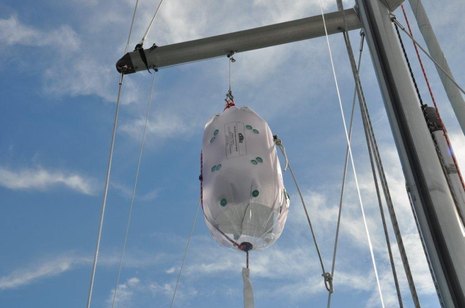
July 2006, Block Island Sound is enveloped in patchy fog, two radar-equipped sailboats pass within 20 feet after failing to detect each other despite calm waters. Neither vessel had a radar reflector hoisted. July 2009, chaos on Block Island Sound as fog descends on hundreds of recreational boaters, skippers constantly calling out on VHF 9 & 16 in attempts to avoid collision. A ferry and a coast guard ship actually do collide . In the melee, just 1 of every 35 boats is sporting a radar reflector. July 2010, dozens of boats make their way through hours of heavy rain and thunderstorms into Nantucket Island, and only 2 have radar reflectors. May 30, 2011, 30 sailboats travel in heavy fog across Long Island Sound from Huntington to Saugatuck, the heavy fog was forecast…the number of boats sporting radar reflectors…just one. Geez, when did safety slip to the bottom of sailor’s priority list? Are radar reflectors so difficult to use? Too confusing maybe? Or is there an overall lack of faith they are worth the effort to hoist?
It seems like nearly all sailors in the Northeast fail to use their radar reflectors. On foggy days in the northeast USA I have observed, at most, 1 in 35 sailboats sporting a radar reflector, and among them most had severe limitations being fixed mount, too small, not kept level, and more than half a combination of all three limitations . Comparatively, 90% of over 50 sailors I informally surveyed, claim to own a radar reflector, in a locker, somewhere. 100% of them described a Davis or Davis-like design . 0% have used them.
Well, no more excuses! The Echomax 230 I Inflatable passive radar reflector is an easy to deploy reflector with no sharp edges, no confusing instructions, and although big, is so soft and cuddly you can leave it up in your rigging days on end without worries and be assured, when bad weather appears, the radar cross section of your sailboat becomes significantly increased making it easier to be seen by others around you.
This product was designed for use on a life raft after storage in a ditch bag, but I have found that it overcomes the barriers to continuous use of reflectors on sailboats, as proven on my sailboat after five seasons and 3400 nm of sailing in the Northeast.
There are numerous articles written about passive radar reflectors defining how performance should be measured, limitations of various designs, and some exposing that various products are entirely or partially ineffective. Not too much new has been written recently. The articles going back to 1991 could be summed up as follows:
- Radar reflectors don’t provide a uniform reflection around their perimeter; there are high and low points around a 360 degree arc , for instance.
- Radar reflector performance is measured as radar cross-section (RCS) in square meters. An RCS of 10 is considered to be an acceptable value for reflection performance, the point at which another ship’s radar will reliably paint a protected boat on an operator’s display.
- There is no substitute for having a big radar reflector as no fancy design (yet discovered) can enable a small radar reflector to be as effective as a larger one. The result is that reflectors that are large enough to deliver an RCS of 10 across much of a 360 degree arc around your boat, need to be of sizes like 16 inches round or larger.
- Even at these sizes, the majority of products on the market don’t achieve a minimum acceptable level of RCS > 10 in all directions around the boat without some degree of care by the owner to maintain correct orientation.
- Various fancy designs are better overall across a 360 degree arc than others . Such designs known as “octahedral-type reflectors” mounted in the “double catch rain position” are measured to be the most uniform around a 360 degree arc and therefore, make your boat more likely to be seen.
- The David Echomaster is an example of such a design, but it becomes ineffective if tilted even a few degrees from the double catch rain position, as the reflected radar energy is greatly reduced. (Page 28, Report on the investigation and loss of the sailing yacht Ouzo, Marine accident investigation branch, United Kingdom, April 2007 ).
It was in fact the David Echomaster I decided on in 2006 for my new 39 foot sailboat. It had the prerequisite of being large, had the best overall performance, and I convinced myself I could keep it in the double catch rain position so it would be effective. I kept it stored in a locker folded up in the protective plastic pouch it comes in, ready to be deployed.
And there it sat and I never used it. Each time I should have, it remained in the locker. Either I had too many other things to attend to during bad weather, it was unsafe for me to be on deck or I was in the state of mind that I could use my own radar to keep distance between me and the other boats nearby. Three near collisions later, I was nervous. I purchased an active radar reflector at a West Marine closeout, but then returned it due to the difficulty in installation, its weight and the serious limitations it had interacting with more than one radar at close range.
That winter I began to seriously look at my original second choice, an EchoMax 230. I originally didn’t like that the product was huge and that the best position to mount it was forward of my mast where it would disrupt the wind from attaching to the mainsail. Also the weight of the reflector and mounts aloft were undesirable. But, it had no sharp edges and could be left up all the time, insuring that it would be used when needed.
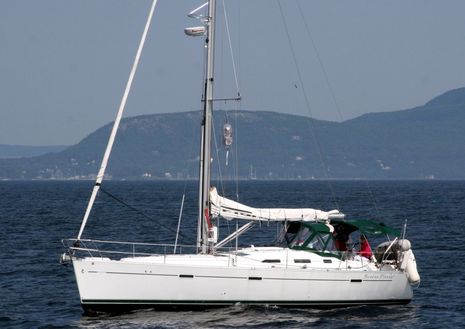
As I was checking the vendor’s site for a purchase, I came across the EchoMax 230 I inflatable. It was designed for inclusion in a ditch bag, to be inflated in an emergency on board a life raft. It sounded ideal for hoisting on a flag halyard as I had originally planned for the Davis product, but absent sharp edges meant I could leave it in the rigging unattended whenever I was underway, good weather or bad. This would have many advantages:
- I could hoist it at the start of every cruising trip, and with a line run from the bottom of the reflector to the deck, change it’s angle to match the heel of my boat to keep level with the horizon.
- Unlike a fixed mast mount, it would not disturb air on the leading edge of my mainsail (reducing sailing performance).
- Good weather or poor, sailing or motoring, my sailboat would be visible to other ships radar.
I emailed the manufacturer telling them this was how I would use it, and if they thought it was durable enough that I could get at least a year out of it. I was told my application was unique, but they would warranty it for a year if I would underinflate it so there is room to expand on hot days.
What a difference, although its big (size is of tantamount importance) I actually used it all season and was comfortable leaving it up full time. This inflatable:
- was used 100% of the time in bad weather from 2007 through its fifth season on board this year. This is due in large part to the little effort required to set it up as part of my routine before setting sail, effectively insuring it’s just there when conditions of night or fog come to pass. Also, with the soft sides it feels non-threatening to set it up.
- although made out of plastic, it appears no worse for the wear in its fifth seasons, even though it has been up there in some pretty violent winds, thunderstorms, and was accidentally left up in October 2007 during a brutal nor-easter (having forgotten to take it down).
- being an “ octahedral -type reflector” mounted in the “double catch rain position”, provides the best of the various designs available for passive radar reflector. (e.g. 360 degree coverage arc)
- is fairly easy to keep in the required vertical position when sailing by moving a lead from the bottom of the reflector to various positions in the rigging, and it stays in that vertical position during pretty strong winds.
- positioned off the flag halyard, it doesn’t interfere with the wind going across my sails as it would have in a fixed mount, and has never become tangled with my rigging.
- When I queried various vessels underway, including ferries, tow boats, tug boats, and recreational powerboats, they all replied that my sailboat was visible on their radar. I received that same positive response from ferries during heavy rain off Nantucket in 2009, in conditions when radar performance is very poor with limited ranges of only a couple miles.
- In rendezvous with Gizmo last week, Ben was able to compare my sailboat with and without the reflector raised, using a Raymarine HD radar. He was able to confirm the reflector is effective in making Breeze Pleeze more noticable on radar, even with five years of use (the reflector was designed to be stored until needed). In our rendezvous I was next to a large buoy, then out among other sailboats one mile, two, then many miles from Gizmo. In our tests the reflector was partially deflated (to allow room to expand when warm), was 15 feet above the deck hanging from a flag halyard (see picture), and was tilted about 5-10 degrees due to the angle of the wind across the deck. (maximum reflection is achieved when it is level)
The only faults I can find with EchoMax 230 I is a need for lateral reinforcement for continuous use (which is easily added with a bit of line between top and bottom as illustrated in this PDF ), better labeling (how about writing “reflector” in big letters) so other mariners understand what it is, and the warranty is far too short considering it looks like new after five years and a dozen storms. In the area of faults, the marketing is awful, the manufacturer grossly missed the mark when targeting this product for emergency grab bags for life rafts.
Without a doubt, this product is a superb solution for the common sailboat and belongs up in the rigging of most every sailboat from the moment it is underway if there is any chance of poor weather.
– Dan Corcoran is an avid sailor and leads ServiceSPAN , a back office work center automation technology company. {That’s his sloop Breeze Pleeze as a solid MARPA target on Gizmo’s radar.}
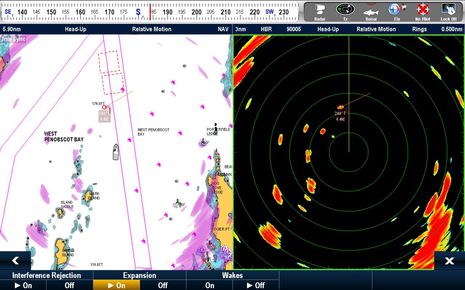
Related Posts:

34 Responses
- Comments 34
- Pingbacks 0
I have the The Firdell Blipper model on our sailboat, although this model tesing turns our to be disappointing we do not sail in an area that has much fog…Miami, FL… Here is a link to an old but very detailed test done on many radar reflectors… http://offshore.ussailing.org/Assets/Offshore/SAS+Studies/radar+reflector+tests.pdf
I wouldn’t claim our testing was definitive, but I definitely saw Dan’s radar target weaken and then strengthen again when he doused and then reset the EchoMax 230I. We did it at one mile and then again at two, and the Raymarine RD418HD held onto its MARPA target for a long time as we drove away in opposite directions. Breeze Pleeze also looked bigger than nearby boats, even though she wasn’t, and that’s a good thing! As I once yakked about in a magazine article about radar reflectors: http://goo.gl/oSJPB At any rate, I think Dan’s done great work identifying a product that overcomes some of the problems of smaller reflectors and proving that it holds up even though it wasn’t really intended for this use. Thanks, Dan!
I consider the MAB report on Ouzo to be definitive. Since then there have been some half hearted attempts to justify other products, with little effect on the market. Why are so few sailboats flying these reflectors? Because inadequate is no better than useless. When a product passes the rigourous testing defined in the Ouzo report, I will buy it. But anecdotal evidence doesn’t get it. Dan I like your work and respect your opinion, but did you ask those tug captains if any other sailboats were visible? And I doubt an average work-horse tug or thirty year old ferry is going to maintain the radar capabilities of Gizmo. Hell, we can’t get many of them to install AIS!
I seem to remember a group test some years ago that concluded that a trash bag full of rumpled aluminium foil , hoisted up , was as good as the better refectors Dave
I have a motor yacht but Dan’s evidence convinces me. Although I’m sure my boat has a bigger radar reflection ability that the average sail boat I’ve had times when we have not shown up on another vessels’ radar. Our AIS signal was the only indication they had of our presence. I’ve ordered a Echomax and I’ll report back after a few months of using it.
Sandy wrote “Dan I like your work and respect your opinion, but did you ask those tug captains if any other sailboats were visible?” Glad you asked, in fact I did. In all of six unrelated communications (with professional working boats) I have been told either I appeared “larger than I should” for a sailboat, larger than nearby boats, “strong”, or some combination of the three. In each instance it was in good weather. I also have experience in bad weather, weather that dramatically increases the challenge of being seen on radar, and I credit this reflector in combination with carefully using my own radar for enabling safe passage. The best example, my family was most unhappy with. I got us caught in continuous rain and heavy thunderstorms traveling 20nm from Hyannis, MA to Nantucket in July 2009. Although not fun, it provided me an important data point as the rain was really heavy, the seas were 4 feet, and nearby fast ferries would confirm we are visible and in one case mistook us for another ferry. The heavy rain impaired my own radar, a 2kw 18” dome at the time, limiting my range to two miles before becoming all noise, within the two mile range it barely showed a 30 foot power boat 500 yards to the east on a course parallel to me. The ferries however were unmistakable on radar, out to about 2 miles. Unable to see the bow of my boat in the afternoon rain, I was near panic when the first northbound ferry approached quickly and head on, closing half the distance it was visible on the radar in half a minute. I hailed her on VHF, and received a confirmation I was visible on her radar, the powerboat however was not. After finding how friendly these folks can be, I made a point to talk to each ferry as it approached and scooted over a 1/4 mile east of the apparent path the ferries were following. Although I was no longer in the way after moving east, a northbound ferry would later reprimanded “me” (identified my boat relative to the position of a nearby buoy) for not answering on another VHF channel and for not following the correct company course. The confusion ended in apology and remark that he believed my boat was another ferry from his company based on a strong return from the radar. I can’t emphasize enough, that size matters when it comes to these radar reflectors and this reflector is quite large.
I’ve been using the Lensref 8″ diam. reflector for a long time, and with good success. Sadly it is no longer made, but they ARE effective reflectors to use for a sailboat heeled at any angle. Maine fog is often thick and this reflector has done well, judging from reports I get from all kinds of vessels that can easily see me on their radar. The design is unusual: a very compact and wind-resistant sphere.
Hi Sandy, We were sent the MAIB report before it was published for our comments as my EM230 was one of those tested. Following our comments they altered three or four of their statements but there were still other opinions expressed which we did not agree with, here are some of them. The EM230 tested had no serial number so was more than 6 years old and was not of latest design. We started numbering the units as soon as we obtained the Ships Wheel Mark in September 2005. The MAIB rang many chandlers to get them to check their stock to verify that all stock on the shelves were numbered. They refused to make this note on the published report. They refused to acknowledge John Firths,the echomax inventors preferred method of fitting for sailing yachts which was suspension from the cross trees of halyard which enables compensation at heel and virtually eliminates mast shadow. Their answer being we supply mast brackets which are requested by the public, our dealers and sold by our competitors. Our website and literature states the clear advantages of suspension. The MAIB/OUSO conclusion that the Trilens was the best reflector was surprising bearing in mind it had virtually half the SPL in the vertical whereas the EM230 had a SPL of 4.7M2. All motor vessels and cats are positioned around the vertical so how can a reflector with half the response be the best one for these craft? Had the MAIB taken on board John Firths preferred fitting for sailing craft then virtually all the 4.7M2 would have been available for sailing yachts. Recent tests by one of our popular sailing magazines found that there was no discernable difference at heel. In this test the EM230 came out best buy as it was still responding at 7.3 miles when they ceased the trails. The MAIB refused to acknowledge that the Echomax symmetrical array excites during real sea conditions. This fact was well documented in the MCA/QinetiQ sea trials in January 02 where the EM230 at 5 miles plus recorded 100% paints at X band and 80% plus at S band. QinetiQ stated that the S band results defied all the laws of physics and at their request two further EM230 were sent to their anechoic chamber for testing which confirmed the sea trial results. This was attributed to John Firths ‘Glint effect’ which is a reaction of the phases, rather like the mirror on the hill scenario. Echomax is one of the very few radar reflector manufacturers in the world to publish independent data on each and every product it makes. The EM230-400 are taken regularly by the US Navy and other foreign navies for target use. The EM305PE is fitted by the US Nuclear Subs, Hawaii. Regds John
There is also the following report published by MAIB but carried out by QinetiQ: http://www.maib.gov.uk/cms_resources.cfm?file=/Radar%20reflectors%20report.pdf The preface says that it also was created following the Ouzo accident but this is a radar reflector for pleasure craft comparison, not an accident report. This test also includes an electronic X-band radar target enhancer (RTE), the Sea-me, which compares favorably to all passive reflectors, especially in that it is less affected by angles of heel. Since the report, 3 other models of RTE have entered the market so that there are now two models each from the manufacturers Sea-me and Echomax. Each company offers a X-band only model and a combined X- and S-band model. A yachtig magazine (unfortunately I can’t find it right now, it would have been either Yachting Monthly or Sailing Today) tested the X-band models of both manufacturers against each other and found the Echomax superior because it has equal or better RCS but significantly less power consumption. There is no test that I know of of the combined X- and S-band models. An RTE, apparently, should go on a sailboat’s mast top (not sure exactly why but it seems they all are). With a passive reflector, that is probably not the best location because it is waving around too much so the return, while it may be good, apprears in different places on subsequent scans of the radar and therefore, may fall victim to seaclutter suppression. Mounting it on deck level is not recommended either, for reasons of range, so the truth is probably somewhere in between, wich, on a sailboat, would mean something like halfway up the mast. A passive reflector that is hidden behind metal, like a mast, is ineffective, no matter it’s RCS. Given all this, I can see why Dan’s setup works well (halfway up the mast, away from the mast, large) but still I would much prefer a fixed mount close to the mast on my own boat. From the reports above and the tests that I know of, I have concluded that in order to be more or less sure to be seen, you must carry an electronic RTE. As everything electronic can fail, you are well advised to also have a passive reflector but this is intended as a backup. My criteria for a passive reflector are: – because of it’s function as a backup, it does not have to offer the highest RCS – It should work well when mounted directly to the mast – It’s performance should be affected by heel as little as possible – I will accept low performance but it must be reliable performance This is why I am planning on a Trilens Standard size mounted to the foward side of the mast, halfway up. The Trilens extends outside of the mast profile so I expect resonable performance even with a radar looking at me from dead astern. This will go with an Echomax X-S-band RTE. The RTE will go on the mast top. There is an expensive but nifty combined anchor- and tricolor LED navigation light by Hella Marine ( http://www.hellamarine.com/default.asp?a=3&t=3&View=FullStory&productID=792&pcid=191 ) that allows another device to be mounted on top of it and the cables of the other device to pass through the center of the light. I think this would work with the RTE and this will avoid problems with partially blocking the light with the RTE.
I recently purchased a motor cruiser in Wales and brought it to France. The first thing I did before leaving was to fit a Echomax 230 (rigid not inflatable). This purchase decision was made following months of research including reading the Ouzo Report. I am amazed at the number of boats that do not have radar reflectors fitted or rely upon the cheap (and totally ineffective) tubular products. Despite being described as such in the Qinetic report, this reflector is still on sale in most chandleries in Europe.
Does a 46′ aluminum sailboat with a tall carbon fiber mast and aluminum radar mast need a passive reflector?
A question for Dan, Have you had a look at / considered, the active reflectors. As Henning mentioned above, Echomax & Sea-Me now both have dual X- & S-band active reflectors (RTEs). Looking at the spec.s for power usage, they both look fairly low draws: the Echomax product spec.s from 23mA up to 200mA draw, depending on how many radar “hits” you are experiencing. The PBO magazine test linked through the Echomax website says that 5 active radar hits draws about 23mA from the single X-band device, 10 draws 32mA, etc. To me that seems like a pretty low current draw for the huge extra safety gained. Even at an average 40mA draw, the device is only drawing 1Ahr every 24 hours – seems like a no-brainer to me. And, if combined with an AIS transceiver, I would think it would create a “hard to miss” envelope. If you did look at RTEs, why did you dismiss them? And would you reconsider them given current products (the Echomax products were not around when you installed your passive device). BTW, thanks for bringing this topic back up. We’ve been sailing without a reflector because all the testing I had read convinced me that they weren’t worth bothering with. I think that with the newer products (esp RTEs), there are now products that make it silly not to have one up all the time. We’ll be putting an Echomax Active-XS on our boat, with a backup inflatable such as you use. Cheers, Paul.
Taniwha/Paul : As I wrote above (more detail here), I purchased an active radar reflector (See-Me) at a West Marine closeout (at $49, it was practically free in 2006), but then returned it (buyer’s remorse) due to the difficulty in installation (many), its weight (including cables) and the serious limitations it had interacting with more than one radar at close range. I am not familiar with how RTE’s improved in the last two years. While I am not inclined to think about RTE for myself since the Echomax inflatable is doing it for me, I applaud your interest in including a reflector/RTE solution for your boat AND a transceiver based (not just receiver) AIS. More boats need to be equipped with this safety gear.
Hi Dan, Thanks for your reply. Sorry for the redundancy in the question: I had read that post of your, but then I got engrossed with the report in the link that you posted, and then with the Echomax & Sea-Me websites, and by the time I wrote the post I had forgotten about your comments on the Sea-Me(that’s one of the dangers in skipping around a few different websites whilst researching a topic). Thanks for posting a great topic and discussion starter. Cheers, Paul. P.S. our yacht’s name is Taniwha, hence the user name.
SOLAS does not distinguish between metal, wooden or glass fibre vessels. When viewed from the bowes or stern the vessel would have a very low radar cross section so it would be wise to ignore the composition of the hull and for safety sake fit a passive reflector with the largest possible RCS and also an RTE if budget permits.
I have a question… I own a 40ft steel trawler with a 14ft beam and 24ft mast. The entire thing is made of steel. Do I still need a radar reflector? I frequently cruise near the major shipping lanes in the Great Lakes and I always wondered how visible I was to commercial traffic. I just always assumed that a big steel box would have a pretty significant radar return. Curious…
Message for Albatross/Alabtross The radar signature of a vessel is governed by the number of radar emmissions that are received back by the interrogating radar. If the radar is fitted with ARPA then you need a hit rate of 50% plus to be shown on the radar screen. Beam on the vessel may have a radar image of several hundred or thousand M2 but this will be a spiked image and not neccessarily a consistent one. However the same vessel with a sleek bow or stern and slanting cabin may only have a very limited radar image when viewed bowes or stern on. I only know of one sea trial where a small glass fibre sailing yacht had a beam on spikey inconsistent image of around a hundred M2 but its bowes on was limited to single figures. The responses were generated from the cooker,engine and mast etc. A vessels radar image can easily be tested by approaching a known vessel from about 8-10 miles to see when and what appears on their radar screen.To test the stern response you would steam away from the interrogating radar. This is how the benefits of a passive reflector or RTE can be seen. Stealth bombers are very large but have virtually no radar image as none of the radar signals are returned to the transmitting radar. Likewise the US nuclear subs although 300ft steel objects are basically like large tubes so have a very low radar image when surfaced. Perhaps a word of caution that all sea trials are subjective and weather and sea state can vary the results substantially at any given time. No two tests will be the same. Re Michaels Mast radar reflection image An aluminium mast in a vertical position would give some radar reflective response however at heel would have none. I know of no tests that have been carried out on carbon fibre but suspect it would respond with same qualities as alluminium.
Here’s another vote for AIS transponder. We have sailed with one now for 18 months. We also have a radar and use it in conditions of reduced vis. We usually see other sailboats at least 3 miles away and often they do not have radar relectors. I have not tried an inflatable radar reflector but would like to see a much more definitive test before buying one. So many great looking designs of passive reflectors have turned out to be not very effective (such as the tube ones). The Sea Me active one is commonly used here in Europe where I would guess that more than 50% of boats have some form of reflector. But nowadays the ships are relying more on AIS and offshore in any kind of seaway I think all passive radar reflectors are going to be largely ineffective. Why not get an AIS transponder? Not so expensive and ALL ships will see you guaranteed.
I think the best way to determine and understand your own visibility would be to have someone else take your boat to see and you follow in a boat with a similar radar setup. Nothing would prove more valuable than “seeing yourself as others see you”, because I think general statements about visibility to radar have to be understood selectively. You may find, for instance, that at certain angles of heel and bearing, your boat “paints” well and effectively vanishes at others. Knowing this, you could take action to “reveal” yourself to traffic. Or you could get an AIS, I suppose. I have a steel pilothouse with a fairly high aft deck. While I “paint” quite well, as expected, I can see how in heavy seas, my cambered deck and relatively modest aluminum mast might not reflect as well as I assume to be.
Some additional thoughts: 1) Paul implied we just use AIS, really? I don’t believe AIS is a substitute for a good radar reflector and that his experience at usually seeing sailboats at 3 miles in reduced vis, is normal. Maybe Paul is an exceptionally talented radar user, has a BR24 or Raymarine HD, or maybe reduced vis is just light rain and seas less than 3 feet? I feel AIS won’t help a sailboat such as mine to avoid collisions with other boats that don’t use AIS, as a passive reflector would. I consider the use of all three (radar, a passive reflector, and AIS) as complimentary with little overlap in achieving my goals of collision avoidance. For example the AIS transceiver on my boat does little to help me avoid collisions with recreational vessels under 40 feet that don’t have one. 2) I had a great conversation with John Simpson after the article was published and received some interesting insights and issues around the world. (Thanks John). He is not entirely comfortable with my recommendation, one of the reasons they don’t promote this product for everyday use (only emergencies) is that it isn’t puncture resistant. Mine doesn’t have a scratch after five years, and is less fragile I think than my old metal Davis. Would you all agree with me that puncture resistance is not a necessary trait of a radar reflector? Would that be a concern for anyone? 3) John believes RTE’s are a much better solution for sailboats, especially those without the ability to power a radar. I scoffed at that initially (due to cost, just use a passive + AIS was my answer), but John justified his position well. As valuable as it is to have your own radar for use in collision avoidance, many sailboats don’t have the power available to do so, and in those cases an RTE offers additional valuable benefits over a passive reflector. John pointed out that RTE gives you an alert that other boats are nearby painting you with X or S band radar, RTE requires much less power than a radar, and the far greater intensity will reliably be detected by another ships radar on every sweep, insuring your boat appears on radar sets that use ARPA. After speaking with John, I suppose if I didn’t have a radar I would seriously consider RTE. 4) A commenter above suggested doing a boat swap? Really? I can’t see how you would get an objective measure of your boats viability on radar thru such efforts, and wouldn’t your day just be better spent enjoying your boat? If professional testing organizations are challenged to test on the water (which has lead to many confusing results being published over the years) you and I don’t stand a chance. The primary issue is that our radar sets don’t report back a number value we can read of the radar energy returned and compare that to the recommended amount to be seen in bad weather. What we do know is that virtually all recreational boats are below half the recommended radar cross section performance for a passive reflectors. Within reason, none of us have any reason to believe our boat is an exception. Even forty foot metal hulled recreational boats don’t reflect 10 square meters in all directions, for example in the arc from 0-80 degrees either side of the bow, I would suspect the curved surfaces of a metal boat are rather stealthy as they reflect radar energy out to the side, into the water, or sky.
I agree with John Simpson. An RTE is the most effective way to announce our presence. AIS B will alert Solas Vessels over 300T and give our position, heading and course on even the oldest AIS A units, but smaller vessels are a threat. We are still assuming they have radar. I believe that a passive reflector does more harm than good by giving crews a false assurance of safety. It only has to be inadequate one time to make a tragedy. Side note; I had a customer who was adamant that his radar would be seen by big ships. Some how safety information manages to get garbled even among those with enough earning power to buy a boat. Sandy Daugherty Retired NTSB Accident Investigator
Hi Dan, Yes we do have a fair bit of experience with radar but are by no means experts. And we do actually have an 18″ Raymarine HD Digital radar so perhaps it is that much more more effective than regular radars. But I still recommend a See-Me or equivalent RTE if you really want to be seen on other people’s radar. Almost no power to run and not that much money. More and more people are getting an AIS receiver so why wouldn’t you add a Class B transponder. Then they will see you. As Sandy Daugherty says, if you hoist an inflatable radar reflector you are still hoping someone has a radar and is actually looking at it. Get an AIS transponder and you know all ships will see you – plus an increasing number of yachts as well.
Paul, a Raymarine HD Digital Radar! That is much better than a regular radar, and explains your experience to “usually see sailboats within 3 miles”. In your eyes there may not seem to be a benefit to a passive reflector. Regular radars are not that good. I also have the HD digital also, and for collision avoidance, I rank this or any other radar as my number one tool, mostly because my greater fear is to be hit by a yacht (rather than a ship) without radar or an attentive helmsman. I do already use an AIS transceiver as well, yet you will find this reflector up in my rigging whenever visibility is reduced and even on most clear day’s because it is no hassle at all to use, and even with great radar, I can’t just run away from every approaching yacht to avoid collisions. We all have responsibilities to hold our course in many passing situations, and need yachts with regular radar to see us also. I also have to admit (to Sandy), I do get a cheap thrill when other ships avoid me and I can instead hold my course and get where I am going in a straight line. Sandy, you wrote that a passive reflector “does more harm than good” as it “provides a false sense of security” I guess you can go there, but can’t that same line of reasoning, a false sense of security, be carried over to an RTE or any safety gear as well? Is that a reason not to purchase one? Or, is your comment really based on a disbelief in my review? If Ben can pass you my cell phone number, give me a call as I would really like to give your point of view a fair listen, as I have John Simpson’s. Speaking about John, he has urged me to write that his RTE product is the only RTE approved by the FCC in the USA. I had purchased (and later returned) his competitor’s product not realizing it wasn’t legal, I guess that could happen to anyone, but relax John, that is probably very rare. Back to the passive product I use above, there is an element of cost in all this. While not an inexpensive cheap thrill as my last safety recommendation, at $180 what’s not to like about this passive radar reflector that you will actually use (rather than leaving in a storage locker), and will do better than double radar visibility of a 40 foot cruising sailboat in clear weather, and in seas taller than your boats deck, make the difference between being seen or not being seen at all?
I use both an echo-master on the halyard, and a tri-radial on the mast. What is the consensus for using two radar reflectors? I have heard some comment that there could be destructive interference, but I do not believe this to be the case if they ar separated by more than several feet. Regard, Bob
There could be interference, both destructive and constructive, even if they are well separated. But does it matter? There is no simple answer to this. Even the direct return from a radar reflector and the return which bounces off the water surface can interfere. Here are some links for you: http://www.theradarreflectorsite.org/WebManuscript/PREFACE.pdf http://www.theradarreflectorsite.org/WebManuscript/CHAPTER%202.pdf
Radar is only as good as the product of the power of emitted signal, RCS, sensitivity of receiver, noise filtering and algorithm/operator to determine a contact from blips. Any of those being low, the ability to detect a vessel/ATON is reduced. Commercial vessels are required to have trained watch standers and will have sufficient power and likely good sensitivity, so all that is variable is the RCS. Their antenna will be quite high up, mounted above highest superstructure to give 360 sweep. You may be indistinguishable from sea clutter in a typical recreational vessel Getting your reflector high up above waves is a good first start. The tests on various shapes and styles are somewhat colored by static positioning. The case of a flat sea is somewhat rare, though we did traverse Fundy in “forestay fog” with a commercial vessel on right angle heading back in 2004. With an old Davis pie plate he was seeing us at 5 miles when we hailed based on MARPA to confirm his holding course. The Maine and Nova Scotia lobstermen tend to have fixed reflectors on poles, but will rarely have a watch if they are working. How many recreational vessels do you expect both mount radar and have trained operators watching screen? AIS is probably your best bet to provide a warning to/from commercial traffic, and a frequent & loud horn for recreational.
Crossing Long Island Sound in the fog and rain Memorial Day morning, was another opportunity to use this reflector. It takes about 2 minutes to rig it, even though I had not done so yet this season. Even thought the water was flat, several of the boats I was crossing with in the club were nearly invisible in auto gain on my Raymarine radar until the fog lifted. The boat with the standard davis reflectors were clear, and it was hit and miss with the boats that did not have reflectors, sizing having nothing to do with it. Interestingly the largest boat was hard to find even with the gain turned up to near 100%. AIS is still rare here. You cannot count on it being useful to advertise your position to other recreational boats. In a club of almost 100 sailboats, we have two boats equipped. Granted most people did not want to be out yesterday, only 2 moving boats were broadcasting AIS other than the ferries and I.
I think I agree with the last comment about the value of passive radar reflector, first because they enhance the signal and second, more important, because they do it even if you’ve lost all your electronics and there is no electricity left. In France there are also useful to identify UK boats as they are the only ones to carry one high on the mast. May be they are more use to fog than we are … or more cautious.
Dan, I am in agreement that a good reflector up high makes a recreational vessel a bigger “target” for the larger vessels, it’s a very appropriate strategy, and yet while necessary is insufficient. A Class B transponder gives them not only a target, it provides a DSC direct call capability to hail with my vessel name, knowing my SOG&COG; a bit more compelling than hearing ” vessel at Lat/Lon heading 275 at 5 kts” that they would get from (M)ARPA. My point is that in my experience, few recreational/small commercial boaters have or likely use radar competently. In the Alameda Estuary their are few vessels with class B transponders that show as on when moored, not sure how many are to be found while moving, or if the same blithe spirits who don’t use radar have the AIS alarms silenced on their VHF/chartplotter. We are in a very active commercial port, where VTS is handling container ships, bulk haulers and tankers. My choice is to give the best chance of being “seen” to all who pay attention, with the best chance to hear them if they need to call. Hopefully, by being on their radar, tagged I become of less concern. My monitoring of the radar/AIS overlay is my defense against those who don’t have AIS transponders, to sort out the moving returns and categorize as of concern or not to me. The idiots will be with us, I just hope to keep from meeting them in the fog.
You have a very good point that few recreational craft have or use radar, and larger boats are equipped with AIS receivers. Having my own radar is far more valuable than the reflector when around other smaller craft, and AIS had advantages when around larger craft. As I dwell on what your wrote, the radar reflector hardly seems to add any more protection in those instances. Who knows, maybe I should get off my soap box about the reflector being valuable. But, radar isn’t entirely the answer either. I am embarrassed to share that I was caught unaware yesterday as two power boats came head-on through the middle of our closely spaced flotilla seen here in the fog. https://www.facebook.com/photo.php?fbid=10156989752550608&set=gm.876988162445151&type=3 Was I inattentive? Was there something about the heavy mist interfered with my seeing the powerboats, just like I could not see 3 of the 8 sailboats in the flotilla around me, despite flat water, calm air, and less than 1/16 mile of distance? Just like AIS is more effective when we all have it, radar is more effective when we all have radar reflectors. Hmm, since that isn’t happening, forget the radar reflector, hey everyone, get radar and AIS!!!
Once the fog partially lifted, the other 3 sailboats showed up clear on radar. Wonder what that was all about! I thought it took heavy rain and/or waves to diminish radar that much.
In that club with 100 sailboats of which two have AIS transponders, how many more have AIS receivers? The Echomax website now has three sizes: the EM230i, the EM230i Midi (same diameter, somewhat shorter), and EMAO3i (spherical, larger diameter)
I know the commercial guys are required to have both. Recreational neither, but just looking at boats in our YC, it seems that above 30 ft power & 35 ft for sailboats seems to be when you see radars and at 40 ft they are pretty close to a given. With modern VHF DSC/AIS integration coming below $500 and a Radar still well north of $1000 I would expect AIS first on the smaller boats. You can get a receiver for http://www.westmarine.com/buy/em-trak-marine-electronics–ais-r100-receiver–12333969
None have AIS receivers. On the bright side, several now have their VHF radio configured with registered MMSI numbers and NMEA0183 integration with their GPS.
Join the conversation Cancel reply
Your email address will not be published. Required fields are marked *
Save my name, email, and website in this browser for the next time I comment.
Don't subscribe All new comments Replies to my comments Notify me of followup comments via e-mail. You can also subscribe without commenting.
Editors' Blog

My test bench runneth over with lithium from SFK, Mastervolt, and Epoch

Handsome Duffy 37 flybridge cruiser seeks new owner (Gizmo is for sale!)

Charging LiFePO4, what’s the impact of lower voltages?

Getting Technical: Standard upgrade

Getting Technical: The winding road ahead
Join our list and be notified of new posts, subscribe to panbo.
Subscribe to Panbo to be notified of new posts and content
Press Releases

Recent Panbo Comments
Recent forum posts.
RE: Simnet Deterioration
You're not alone. I had similar issues with some Simne...
By Bill Kearney , 4 weeks ago
Simnet Deterioration
I'm having to run a new robnet cable and replace an AP1...
By Clint Wadsworth , 4 weeks ago
RE: N2K Rode Counter
did you ever find anything out about this? I have also ...
By Scott Badgley , 1 month ago
Vesper Watchmate AIS XB-8000 for sale
I am selling my Vesper Marine XB-8000 AIS transponder. ...
By Juan Rodriguez , 2 months ago
RE: Engine data on plotter and analog gauges
The downside to alerts is you don't always see them, an...
By Bill Kearney , 3 months ago
@wkearney99 I agree, Bill. But I also think that well-c...
By Ben Ellison , 3 months ago
Yachting Monthly
- Digital edition

How well does your radar reflector work?
- Dennis O'Neill
- August 23, 2012
Yachting Monthly finds out

We looked at 10 radar reflectors – from £15 and £499 – testing them in a lab and at sea. The results, as Toby Hodges discovered, were startling
Click here to download the article

- Forums New posts Unanswered threads Register Top Posts Email
- What's new New posts New Posts (legacy) Latest activity New media
- Media New media New comments
- Boat Info Downloads Weekly Quiz Topic FAQ 10000boatnames.com
- Classifieds Sell Your Boat Used Gear for Sale
- Parts General Marine Parts Hunter Beneteau Catalina MacGregor Oday
- Help Terms of Use Monday Mail Subscribe Monday Mail Unsubscribe
Mounting a Radar Reflector
- Thread starter Bob S
- Start date Jun 16, 2009
- Forums for All Owners
- Ask All Sailors
I just bought a Plastimo 2" x 22 Radar Reflector. Has anyone used one of these on their boat? Just curious how you mounted it. I was thinking of using a heavy duty electrical tie to attach it to a stay above the shroud. Any suggestions? http://www.defender.com/product.jsp?path=-1|135|1066430&id=82809
Stu Jackson
Good idea We did this for a temporary rig for an ocean trip. No reason you couldn't zip tie it to the top of the forward lower up at the tang at the mast.
Attachments

Above The Spreader Mine is mounted just above the first spreader with monel wire. It has been there for at least ten years, probably 15.
Rich Stidger
I have the larger size and I have attached it just above my second spreaders using small screw-type hose clamps. I would not use wire ties due to the UV degradation of them. I know that there are some black ties that are resistant to UV, but I felt that security of the metal clamps was better. FWIW, I had water intrusion in my reflector after a year and I drilled a 3/16" hole in the bottom cap to allow any water to drain. I don't take it down over the winter and I didn't want a freezing issue. Maybe my reflector was not sealed as well as it should have been, so your mileage may vary.
Just be aware that the Plastimo radar reflector isn't very good compared to some of the others in terms of showing up on radar. Also, the reflector really needs to be mounted as close to vertical as possible for best results. If you're going to use cable ties to mount it, use the black ones, as IIRC, they have the best UV resistance. Personally, I think using a line and lashing the line to the shroud would be better than using a cable tie.
"Just be aware that the Plastimo radar reflector isn't very good compared to some of the others in terms of showing up on radar". Based upon actual experience, I don't disagree. But, it is still a meaningful improvement. And, I consider it like a life preserver: the very best one is the one you wear most. This offers minimal windage and weight and you mount it and forget it.
Bob— The Davis Echomaster Deluxe is a far better unit, and less expensive too boot. I use it on a halyard that goes to the upper spreader on my rig, and there are two blocks mounted to the underside of the spreader, which allows the radar reflector to hang without chafing the halyard. I leave it up 95% of the time—taking it down for bad storms when I'm not sailing. The trip to Nantucket is a good one.. but keep an eye on the currents, especially when going through Woods Hole, and watch out for the fog and ferries.
Mobri / Plastimo do not perform well. SD explained it. Here's a link to some of the testing that has been done - http://www.ussailing.org/safety/Studies/radar_reflector_2.htm#Mobri You would be much better off and safer using one of those foil covered cardboard ones that you hang in the double catch rain position. You would have saved a lot of bucks too.
Don't use the cable ties unless it's really temporary. My dealer installed mine with cable ties (I didn't know) and they came off-could have hit someone or something....Lash or clamp it in place properly. The larger size (Rich's setup) is much better than the littleones-If you can, return it and get the davis-we've done tests, and they are much more effective.
Doesn't Matter How You Hang It or even whether you hang it at all. Every report I have read states this type of reflector has no detectable response at all. See US Sailing report:- http://www.ussailing.org/safety/Studies/radar_reflector_test.htm
Considering that the 4" version did poorly, I'd hate to think how well the 2" version does. IMHO, getting the 2" plastimo/mobri radar reflector is a poor idea, since it really does nothing to increase your radar profile significantly—and can lead to a false sense of security. The Davis Echomaster Deluxe is less expensive, and has a much greater radar return generally.
sailingdog said: Just be aware that the Plastimo radar reflector isn't very good compared to some of the others in terms of showing up on radar. Also, the reflector really needs to be mounted as close to vertical as possible for best results. If you're going to use cable ties to mount it, use the black ones, as IIRC, they have the best UV resistance. Personally, I think using a line and lashing the line to the shroud would be better than using a cable tie. Click to expand
Maine Sail said: I would honestly say that I have never not seen a boat with ANY reflector... Click to expand
Maine Sail said: Tests schmests..... In my own real world experience I would honestly say that I have never not seen a boat with ANY reflector and missed LOTS without reflectors. Sure there is a "range" of performance but even the worst performing radar reflector, when properly used, I find works MUCH, MUCH better than none at all. It's not like we don't get to use our radrs much up here in Maine eitehr... Click to expand
sailingdog said: Yes, but why pay MORE money for a radar reflector that is CLEARLY LESS EFFECTIVE??? BTW, I was basing my statement on efficacy on both tests and RW experience using radar. Click to expand

I leave my Davis Echomaster up most of the time, except if we have a storm coming in. It is hoisted on a halyard that was setup just for the radar reflector, which has two blocks mounted about a foot apart on the bottom of the top spreader, to prevent the refelctor from chafing the halyard.
like maine sail, we did some informal tests in our rare maine fog during our annual Maine Hunter Sailing Association flotillas. I agree any reflector is better than nothing, but.. Escape showed up better with the Davis than with 2 of the small Mobris, and much better with the medium size tri -lens. Once the mobris fell off, we installed the tri-lens on the mast-I'll report back after we do some testing. As maine sail said, anything up is better than a reflector in a locker
Radar Reflector Performance Now that we have the attention of the experts I thought it might be appropriate to toss this into the ring. After the assumed running down of a small yacht on a clear night by a ship - and the loss of three lives, the UK govt department dealing with such matters did an analysis of the probability of a yacht with a reflector being seen by a ship's X band radar. The weather conditions were a brisk breeze but nothing approaching heavy weather. At no time did the ship's radar 'see' the yacht nor was there any record on the ship's voyage data recorder. The lookout did not see the yacht's nav lights until 300 yards range and the yacht then passed close down the ship's side. It was not established whether a collision occurred. The ship did not stop not did it call the Coastguard. The captain is now in jail. The yacht was understood to be wearing a Davis reflector in the double catch rain position and by common agreement the Davis is amongst the best reflectors for yachts. The attached graph shows that regardless of reflector area there are distances where the yacht would have zero probability of appearing on the radar screen. Most notably at 2 miles and 4 miles (6 minutes apart at 20 knots). So if this was when the OOW looked at the screen the guys were as good as dead already.

Donalex said: The attached graph shows that regardless of reflector area there are distances where the yacht would have zero probability of appearing on the radar screen. Click to expand
- This site uses cookies to help personalise content, tailor your experience and to keep you logged in if you register. By continuing to use this site, you are consenting to our use of cookies. Accept Learn more…
- Set/Update Preferences
- Set This Location

World > Asia > Russia > Moscow
Moscow, Russia Weather Radar Map
Quick weather clicks, moscow radar loop weather.



IMAGES
COMMENTS
Radar Reflectors (more accurately called Radar Target Enhancers, or RTEs) reflect radar energy from other vessels' radars so that your boat shows up as a larger and more consistent "target.". If you operate your boat in areas with shipping traffic or where fog and low visibility are common, the ability to be seen by radar-equipped ships ...
By The Rigging Company July 7, 2015. A radar reflector is used to help make your vessel more identifiable by other boats and ships that use radar to scan for vessels as well as other obstructions. In the world of radar reflectors there are many, many options. For sailboats the options are narrowed down a bit, but there is still much controversy ...
This is how we tested. The echo of each reflector was measured a total of eight times - from a distance of 0.5 and 1.5 nautical miles, vertically and at an angle of 30 degrees, using a modern broadband radar and a conventional magnetron radar. The displays of the broadband radars are shown in the individual test images.
Shop boat radar reflectors at West Marine, including tubular reflectors, Echomaster reflectors, and more. Enhance your vessel's visibility and safety. Get free shipping to home or in-store pickup today! 6LchHDMbAAAAAGPRKfV4mVX9FPM_gdroO62T7nWA. Enter Zip Code
The Plastimo 39099 Tubular Radar Reflector for Small Sailboats features a groove for shroud mounting. Grooved ends keep the unit lined up with the shroud. Tubular shape minimizes windage and chafe on your boats gear. Eyes on both ends of the reflector allow the unit to be secured snugly to the shroud. The reflector's cylindrical shape is ...
Let us help. 206-632-4462. Email. Enhance your boat's visibility with a high-quality radar reflector. Shop marine radar reflectors, including options for sail and power at Fisheries Supply!
If you need assistance with what type of radar reflector you need or finding a specific one, contact our customer service representatives during business hours at 1-860-701-3400 or 1-800-628-8225. Shop Radar Reflectors for boats of all types at Defender. Get fast delivery and free shipping on eligible orders over $99.
Tri-Lens Radar Reflector In our 1995 test, a recommended minimum average RCS of 2.5 m2 was adopted at the suggestion of GEC Marconi, maker of the Firdell Blipper reflector. ... Practical Sailor has been independently testing and reporting on sailboats and sailing gear for more than 50 years. Its independent tests are carried out by experienced ...
Radar reflectors can be mounted to the masts of boat cabins as well. To start to make sense of this, we need to delve into a bit of radar history, and have a rudimentary understanding of how it works. In 1904 a patent for "an obstacle detector and ship navigation device," was issued - this device used radio echoes to determine the approximate bearing of objects
Radar Reflectors Octahedral Type Radar Reflector For Sailboat, 10pcs Aluminium Radar Reflectors 12x12 Inches for Sailboats Motorboat, Marine Aluminum Radar Reflector for Boat Ship. $26.21 $ 26. 21. Buy 2, save 3%. FREE delivery Jul 6 - 8 on $35 of items shipped by Amazon.
Radar reflector requirements on boats. According to the Collision Regulations, pleasure crafts that are less than 20 m long or made primarily of non-metallic materials must be equipped with a passive radar reflector. However, there are exceptions—a radar reflector is not required if the craft is operating in areas with light traffic, during ...
Install a Marine Radar Reflector. A marine radar reflector is used as a way of making small boats stand out on radar systems. Radar works by sending out radio waves and then drawing a picture based on the reflected radio waves. The larger the object, the bigger the reflection. A very small boat will only be shown by a small radar reflection.
Installing a radar reflector on your boat is an essential safety measure that can significantly reduce the risk of collisions with other vessels. By understanding the different types of reflectors available, choosing the right one for your boat, and properly installing and maintaining it, you can ensure the safety of your family and your vessel ...
July 2006, Block Island Sound is enveloped in patchy fog, two radar-equipped sailboats pass within 20 feet after failing to detect each other despite calm waters. Neither vessel had a radar reflector hoisted. July 2009, chaos on Block Island Sound as fog descends on hundreds of recreational boaters, skippers constantly calling out on VHF 9 & 16 in attempts to avoid collision. A ferry and a ...
Radar Reflectors Octahedral Type Radar Reflector For Sailboat, 10pcs Aluminium Radar Reflectors 12x12 Inches for Sailboats Motorboat, Marine Aluminum Radar Reflector for Boat Ship. $27.21 $ 27. 21. Buy 2, save 3%. FREE delivery on $35 shipped by Amazon. Only 5 left in stock - order soon.
Dennis O'Neill. August 23, 2012. 0 shares. Yachting Monthly finds out. We looked at 10 radar reflectors - from £15 and £499 - testing them in a lab and at sea. The results, as Toby Hodges discovered, were startling. Click here to download the article.
Description. Plastimo's vertically mounted Radar Reflector Tube is designed to complement your active radar reflector on your sailboat. Lightweight, compact tubular design offers almost no wind resistance and won't interfere with sails. Tubular shape minimizes windage and chafe on your boats gear. Features a groove for mounting it on a shroud.
Canadian Sailcraft 36T Casco Bay, ME. Jun 18, 2009. #13. sailingdog said: Just be aware that the Plastimo radar reflector isn't very good compared to some of the others in terms of showing up on radar. Also, the reflector really needs to be mounted as close to vertical as possible for best results.
The dBZ values increase as the strength of the signal returned to the radar increases. Each reflectivity image you see includes one of two color scales. One scale (far left) represents dBZ values when the radar is in clear air mode (dBZ values from -28 to +28). The other scale (near left) represents dBZ values when the radar is in precipitation ...
Our HD satellite images of Moscow will show you whether there's sunshine currently in the area, or if clouds are making for a more gloomy day. Finally, current observations will tell you what current temperatures look like around Moscow at the moment, as well as if it's humid and/or windy. Forecast for the next few days - The weather forecast ...
Economy Radar Reflector: A great backup aboard larger boats or primary reflector on smaller vessels that might not normally carry a radar reflector. Made of foam core plastic-metal foil laminate. Economical enough for any boat. Performs nearly as well as Standard Echomaster, and stows flat. Remember to install radar reflectors as high as ...
The weather radar ( Moscow) shows where it is currently raining or snowing. The radar map is updated every 5 minutes with a new radar observation. The different colours indicate the intensity of rainfall or snowfall. Light blue indicates drizzle, blue a medium intensity, and red and yellow indicate very strong precipitation, usually associated ...
Spanish authorities have granted an emergency request for the replica of an 18th-century Russian frigate to make a port call so that it can replenish provisions and replace broken parts, media ...